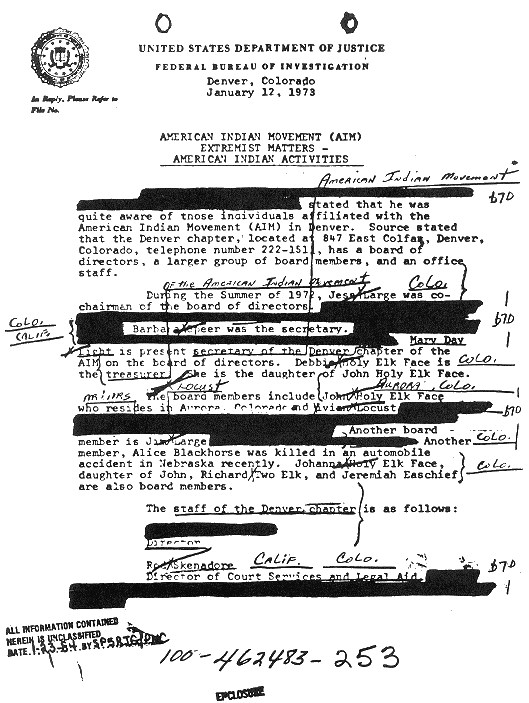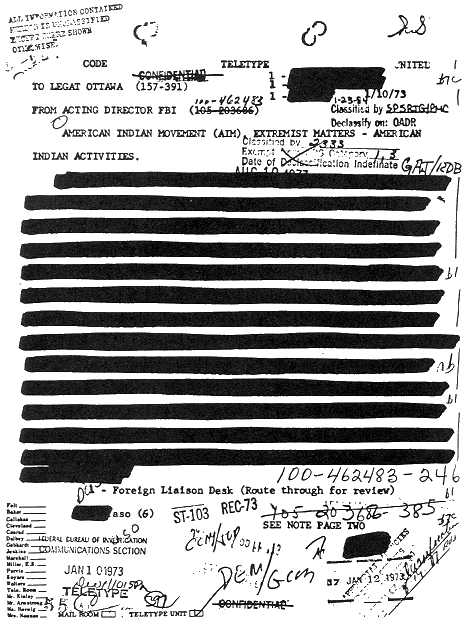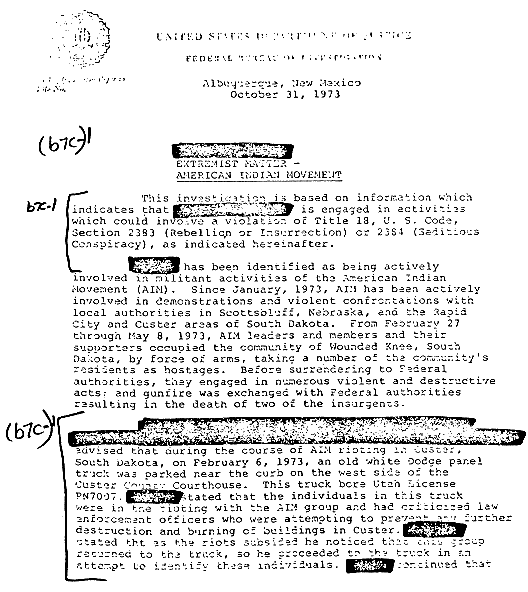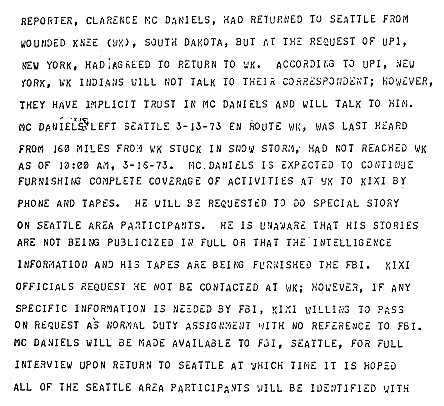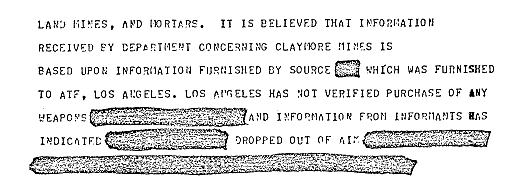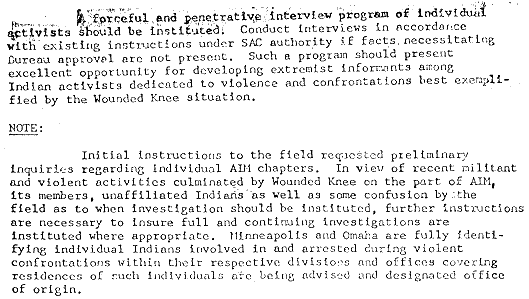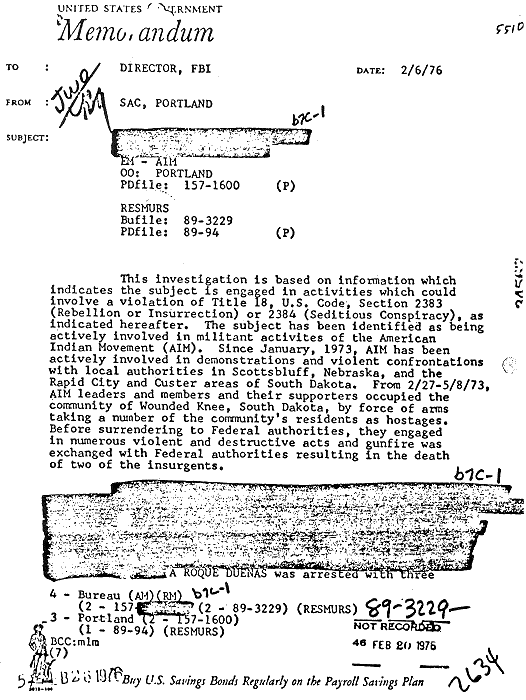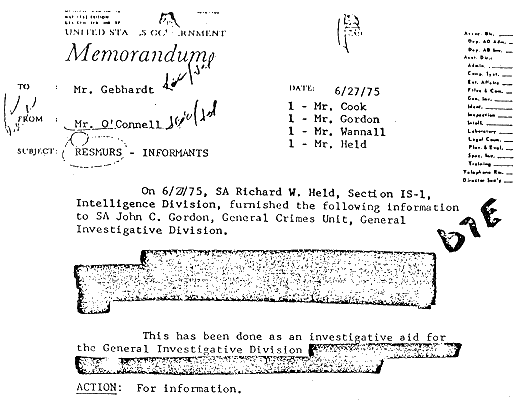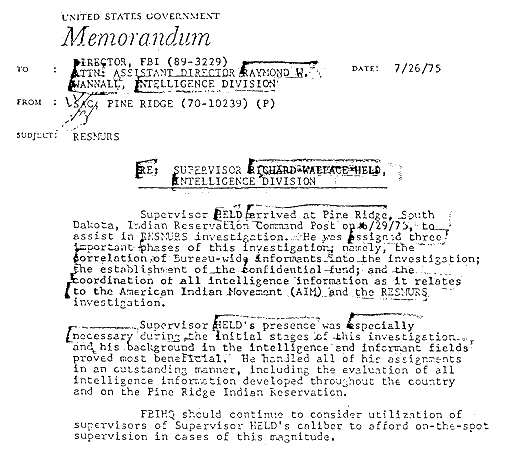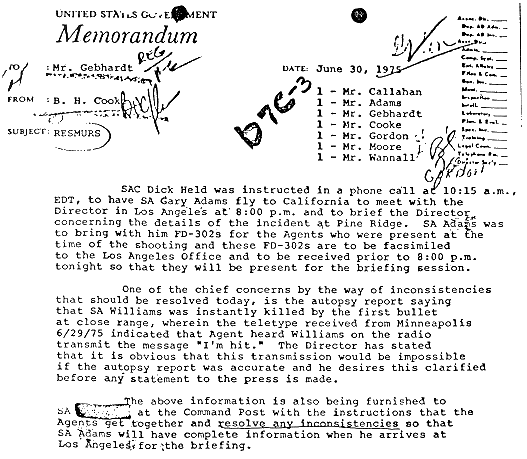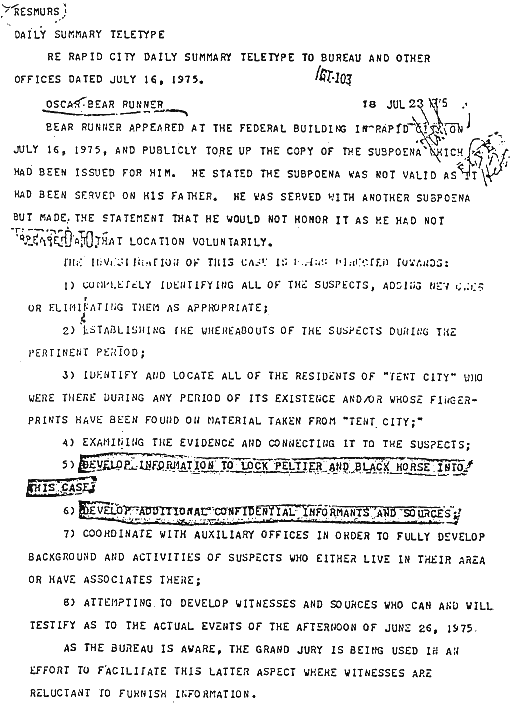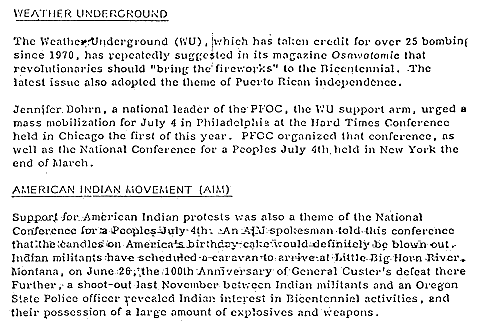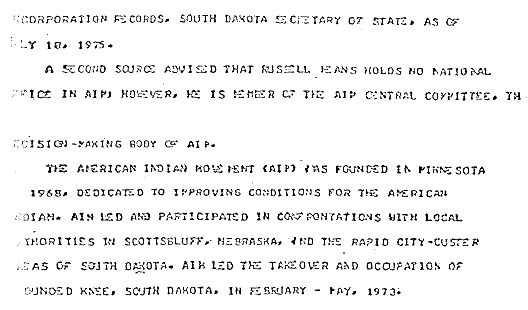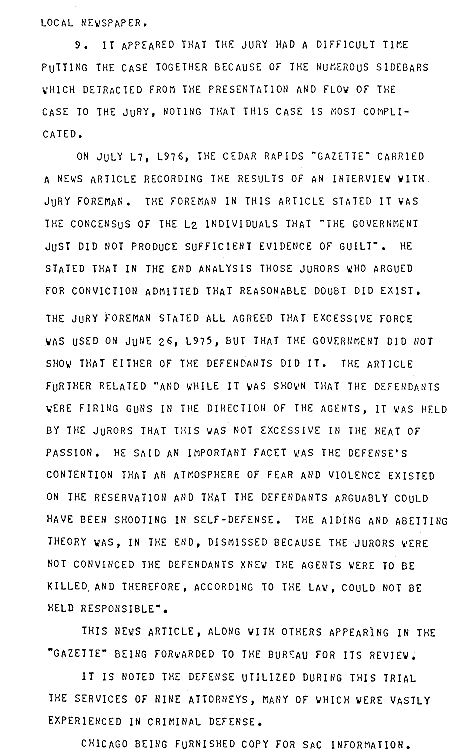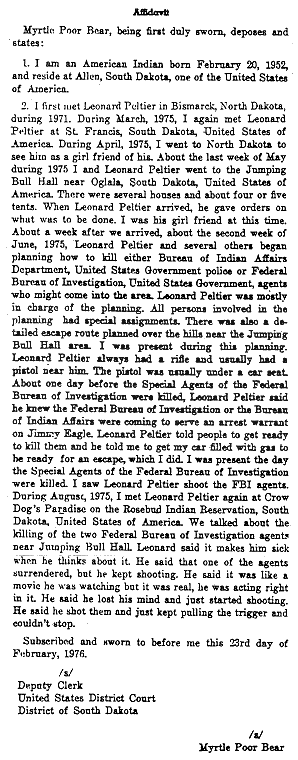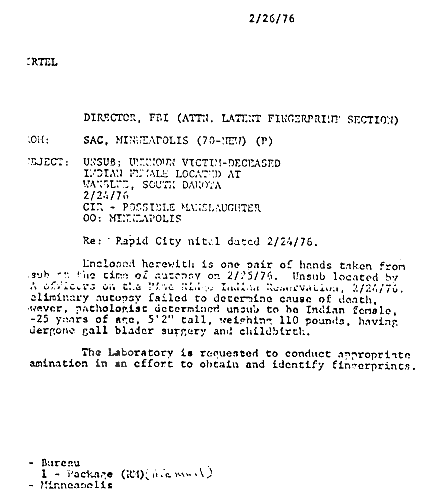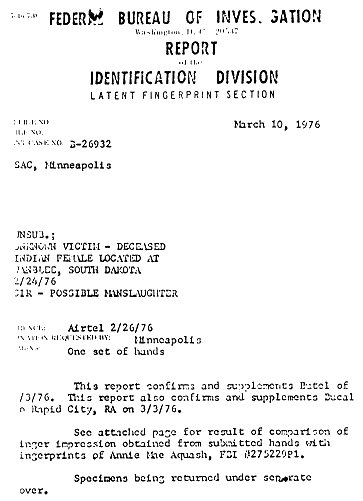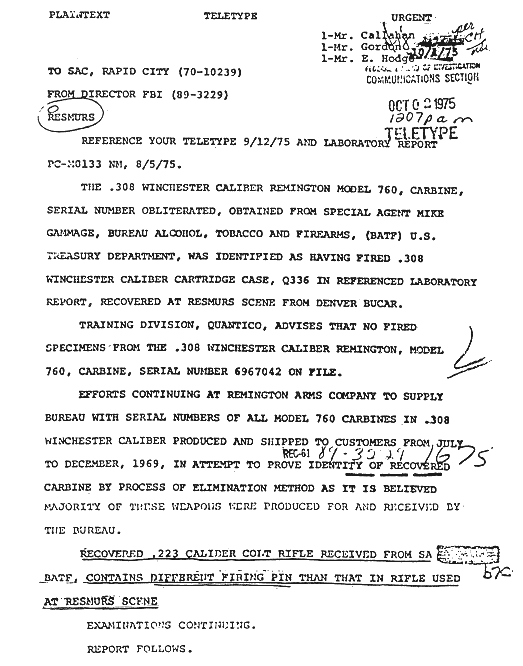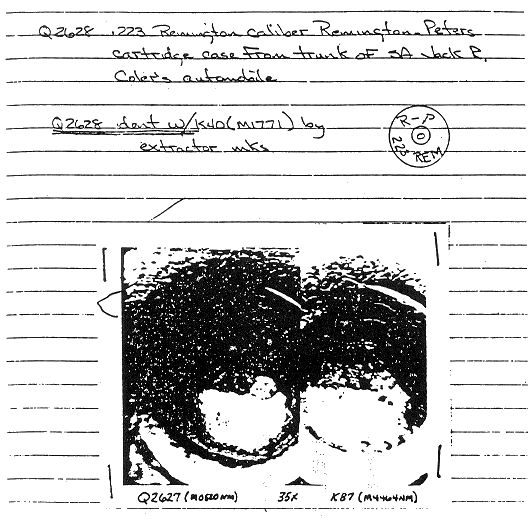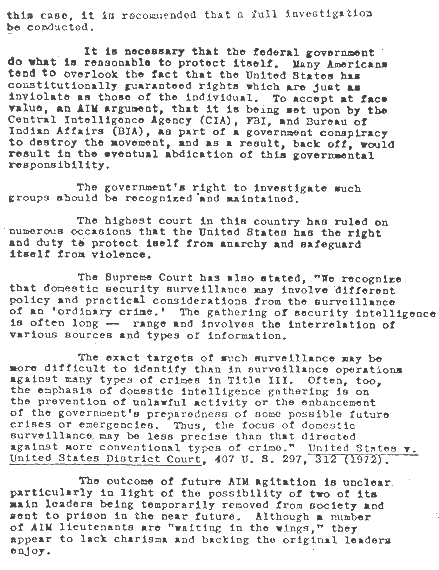In this brief statement, Assistant Special Agent in Charge Zigrossi summarized over two centuries of U.S. jurisdiction and 'law enforcement" in Indian Country. From the country's founding through the present, U.S. Indian policy has consistently followed a program to subordinate American Indian nations and expropriate their land and resources. In much the same fashion as Puerto Rico (see Chapter 4), indigenous nations within the United States have been forced to exist - even by federal definition - as outright colonies. 1 When constitutional law and precedent stood in the way of such policy, the executive and judicial branches, in their turn, formulated excuses for ignoring them. A product of convenience and practicality for the federal government, U.S. jurisdiction, especially within reserved Indian territories ("reservations"), "presents a complex and sometimes conflicting morass of treaties, statutes and regulation." 2The entrance of the FBI in law enforcement into Indian Country began in the 1940s - under clear congressional provisos that it should be neither primary nor permanent - as wartime funding cuts rendered staffing levels for Bureau of Indian Affairs (BIA) Special Officers inadequate. 3 Initially, the Bureau offered mere "investigative assistance" to the BIA, but over time all federal offenses came to be investigated by the FBI. By 1953:
... apparently because of FBI leadership, most U.S. Attorneys, and U.S. District Judges, recognized the FBI as having primary investigative jurisdiction for Federal law violations committed in Indian country, notwithstanding the wording of Congressional appropriation acts since FY-1939 and Opinion M. 29669 dated August 1, 1938, issued by the Solicitor, U.S. Department of the Interior [indicating that such responsibilities were included in the duties of BIA Special Officers]. 4 {see proposed legislation, 1952}The current situation is that:
The BIA has trained criminal investigators on most reservations. These special officers conduct the initial investigation for the majority of serious crimes which occur on Indian reservations. Most U.S. Attorneys however, will not normally accept the findings of a BIA special officer as a basis for making a decision on whether to prosecute. Instead, most U.S. Attorneys require that the FBI conduct an independent investigation, often duplicative of the BIA investigation, prior to authorizing prosecution .... 5All law enforcement on American Indian reservations has been made to revolve around the actions (and inactions) of the FBI. It is undoubtedly significant that while the typical BIA police officer is Indian, FBI agents and U.S. Attorneys are overwhelmingly white. 6Far from enhancing law enforcement, the FBI impedes it by slow response and insistence upon repeating the investigative work of BIA, often well after the fact. Until this process is completed, no arrests can be made and suspects remain at large. 7,7a Once an offender has been apprehended and charged, there is little chance they will be tried: "Precise statistics are not maintained by Federal law enforcement agencies, but it appears that in excess of 80 percent of major crimes cases, on the average, presented to the United States attorneys are declined for prosecution." 8 Unlike crimes committed off-reservation, there is no other jurisdiction under which the defendant can be tried if the U.S. Attorney declines to prosecute. The effect on many reservations has been that defendants have a better chance of going to jail for a traffic violation - tried in the tribal courts - than for rape or first degree murder. Indian/Indian crimes or crimes perpetrated by non-Indians against Indians ranging from fraud to extreme violence - have received only minimal (if any) attention from police and prosecutors. Only those allegedly criminal acts undertaken by Indians against whites have tended to receive attention, filling the country's prisons with a disproportionately high number of Indians. 9,9a In this sense, it is entirely appropriate to observe that federal police functions in Indian Country are not devoted to law enforcement per se, but rather to maintenance of the status quo represented by Euroamerican domination and profiteering at the expense of American Indian people. The message has been that only those who rock the politico-economic boat risk criminal punishment.
With the passage of PL-280 in 1953, state and local agencies- also almost entirely white - assumed responsibility for on reservation law enforcement in many instances. 10 The overall effect of these policies has been that the quality of law enforcement in Indian Country has been egregious when measured by the standard of providing for the safety and security of the communities. Law enforcement concerning the most serious crimes is the responsibility of individuals who do not reside in the community and whose attitudes toward Indian people and their customs range from ignorance to hostility and contempt, a la Norman Zigrossi. In the case of state and local jurisdiction under PL-280, law enforcement is provided by reservation-adjacent communities with a reputation for vehement racism aptly summarized by an Itasca County, Minnesota, deputy sheriff. "[I]f all those Indians would just kill each other off, we wouldn't have to go up them [to the reservation]." 11 Slow to respond to complaints lodged by Indians, the police are viewed - justifiably - with suspicion by the community. 12
Rise of the American Indian Movement
The late 1960s saw a resurgence of militant Indian activism focused on resistance to further depredation of Indian lands and resources, recovery of illegally expropriated land, preservation of cultural identity and opposition to racist attacks on Indian people and their culture. During the mid-'60s, a Cherokee college student named Clyde Warrior founded the militant National Indian Youth Council (NIYC) and began publishing a political broadside entitled Americans Before Columbus. 13 Even the typically staid National Congress of American Indians (NCAI) adopted an increasingly forceful tone under the leadership of Lakota law student Vine Deloria, Jr, who before the end of the decade was to write the seminal Custer Died for Your Sins and We Talk, You Listen. 14 It was in this atmosphere that the American Indian Movement (AIM) was founded in Minneapolis in 1968 by Dennis Banks and George Mitchell (both Anishinabes [Chippewas]). Patterning itself after the Black Panther Party, AIM initially focused itself on urban issues such as combating police harassment of Indian people. During the next two years members such as Clyde Bellecourt (Anishinabe), Russell Means (Oglala Lakota), Herb Powless (Oneida), John Trudell (Santee Dakota) and Joe Locust (Cherokee) changed its emphasis from a local to a national focus and from specifically urban issues to issues of treaty rights and the preservation of traditional Indian culture. 15
In November 1969, national attention was suddenly focused on Indian issues when a coalition of Indian organizations, headed first by Richard Oaks (Mohawk) and later Trudell, and calling itself Indians of All Tribes (IAT), occupied Alcatraz Island. Citing an 1882 federal statute (22 Stat, 181) which provided for the establishment of Indian schools in abandoned federal facilities, the protestors demanded the creation of a Center for Native American Studies and other cultural facilities on the abandoned island. The occupation ended after nineteen months with an assault by a task force of U.S. marshals and the arrest of the occupiers. A prior agreement by the Department of Interior to convert Alcatraz to a national park featuring Indian themes never materialized. However, the massive media attention and resultant public support garnered by the Alcatraz occupation demonstrated its tactical effectiveness. 16 During the next two years, Indians occupied other abandoned military facilities across the country and Pacific Gas and Electric sites on Indian land in northern California. 17 AIM also engaged in a series of high-profile demonstrations - including the occupation of the Mayflower II on Thanksgiving Day 1970 and of Mt. Rushmore on July 4,1971 - which continued to keep Indian issues in the public eye. 18
In January 1972 an Oglala man named Raymond Yellow Thunder was tortured and murdered by two white men, Melvin and Leslie Hare, in the reservation adjacent town of Gordon, Nebraska. When it became clear that local law enforcement agencies intended to take no action against Yellow Thunder's murderers, a force of over 1,000 Indians - mostly from the nearby Pine Ridge and Rosebud Reservations - headed by AIM leaders Dennis Banks and Russell Means, occupied Gordon for three days. 19 The result of the occupation was that Yellow Thunder's assailants were charged and jailed, a police officer suspended, and Gordon's authorities forced to take a stand against discrimination toward Indians. The effect of this action was described by historian Alvin Josephy, Jr.: "Although discrimination continued, AIM's reputation soared among reservation Indians. What tribal leaders had dared not to do to protect their people, AIM had done." 20 According to those FBI documents assembled by the Bureau in its reading room, it was at this juncture that agents were first assigned to keep close tabs on "AIM and related militant Indian nationalist organizations."
In the light of growing public and reservation support, the AIM leadership met at the home of Brule Lakota spiritual leader Leonard Crow Dog's home - called Crow Dog's Paradise - on the Rosebud Reservation in July of 1972 to plan their next action. From this meeting emerged the concept for The Trail of Broken Treaties. Caravans from reservations across the country would travel to Washington, D.C., arriving immediately before the November presidential elections. AIM hoped that given the timing and attendant press coverage, the Nixon administration might be willing to enter into negotiations to resolve Indian grievances. 21 The Trail began in San Francisco and Seattle in October and gathered support from reservations along its route as it moved eastward. A list of proposed federal actions for redressing grievances and restructuring the relationship between Indian nations and the U.S. - known as the "Twenty Points" - was formulated during a stopover in St. Paul, Minnesota. 22 When the caravan reached Washington, D.C. on November 3, a series of events rapidly led to the Indians seizing the national BIA headquarters and occupying it until November 5. 23 The unplanned confrontation ended when the administration - embarrassed by sensational news reporting - formally agreed to review and respond to the Twenty Points, as well as to non-prosecution of the occupiers and provision of $66,650 in travel expenses for caravan participants to return home. 24
When the government recovered the BIA building, they discovered that a large number of "confidential" documents - primarily concerned with the low-yield leasing of reservation land - had been removed by the occupiers. One of the Trail's leaders, Hank Adams (Assiniboin/Lakota), volunteered to recover the documents and return them in batches, as they were copied and provided to the Indians to whom they pertained. After returning two loads of material, he was set up by an FBI provocateur named Johnny Arellano and arrested by the FBI in the process of returning another. 25 While the government made much in the media of the damage allegedly done to the building by caravan participants:
Later events would indicate that the federal government had a substantial number of agents among the protesters, and some were so militant and destructive that they were awarded special Indian names for their involvement in the protest. It became apparent why the government had been so willing to agree not to prosecute the Indians: The presence of agent-provocateurs and the intensity of their work would have made it extremely difficult for the government to have proven an intent by the real Indian activists to destroy the building. 26It was thus during and immediately following the Trail of Broken Treaties that evidence emerges of the initiation of a counterintelligence program to neutralize AIM and its perceived leadership. An FBI document released to journalist Richard LaCourse under the FOIA reveals a program which closely parallels that directed against RAM in Philadelphia (see Chapter 5). It recommends that "local police put [AIM] leaders under close scrutiny, and arrest them on every possible charge until they could no longer make bail." 27 This tactic was immediately implemented against activists returning home from Washington, D.C. For instance, on November 22 1972, Trail security coordinator Leonard Peltier was attacked in a Milwaukee restaurant by two off-duty policemen; he was beaten severely and then arrested and charged with the attempted murder of one of his assailants. Peltier was eventually acquitted when trial testimony revealed that one of the cops had shown his girlfriend a picture of Peltier and boasted of "help[ing] the FBI get a big one." 28 At about the same time, in South Dakota:As Russell Means led the Oglala Sioux remnants of the Trail of Broken Treaties through the town of Pine Ridge, the seat of government of the Oglala reservation, he may have noticed a stir of activity around police headquarters. Unknown to Means, tribal president Richard Wilson had secured a court order from the Oglala Sioux tribal court prohibiting Means or any other AIM member from speaking or attending any public meeting ... Since the Oglala Sioux Landowners Association was meeting in Pine Ridge, Means, a member of this group, decided to attend and report what had actually happened in Washington. Before he had a chance to speak his mind, he was arrested by BIA special officer Delmar Eastman for violating this court order ... The arrest was a blatant violation of the First Amendment, for it denied Means freedom of speech on the reservation where he was born and was an enrolled member. 29Early report showing intensive surveillance of Denver AIM chapter. The "100" coding prefix at bottom of page indicates an "Extremist Matters" investigation.
Early teletype demonstrating distribution of intelligence information on AIM within the international arena. Heavy deletion results from "National Security" classification.
Documents released through the FOIA, such as the accompanying January 12, 1973 report from the Denver field office, show that the Bureau was compiling detailed profiles of AIM members and leaders as part of an "Extremist Matters" investigation. As is demonstrated in the accompanying January 10 teletype, almost entirely deleted under a national security classification, the Bureau was (for reasons which have never been specified) keeping the U.S. embassy in Ottawa apprised of AIM activities. On January 14, Russell Means and several other AIM members were arrested on fabricated charges in Scottsbluff, Nebraska while participating in a Chicano-Indian Unity Conference with the Denver-based Crusade for justice. That night, Means' cell door was unlocked, a gun was placed in his cell and he was told by the police to "make a break for it." As the AIM leader later put it, "They wanted to off me during an escape attempt." When a complaint was filed on the incident, police claimed that Means had not been "properly searched" when he was booked and that the weapon was found in his cell. The accompanying January 15, 1973 teletype from the Omaha ASAC to the director proves the Bureau was well aware of the situation, but - in a manner reminiscent of the FBI's handling of police abuses against SNCC and other civil rights activists in Mississippi during the early '60s local agents did absolutely nothing to intervene. Bureau records also show the unity conference was heavily surveilled and infiltrated. 30
During the meeting in Scottsbluff, AIM received word that a 20-year-old Oglala, Wesley Bad Heart Bull, had been brutally stabbed to death by a white man, Darld Schmitz, in the reservation-adjacent town of Buffalo Gap, South Dakota. When Schmitz was charged with only the relatively minor offense of second degree manslaughter, AIM national coordinator Dennis Banks arranged a meeting with Custer County state's attorney Hobart Gates to discuss upgrading the charge to murder. Banks issued a call for Indians to assemble at the county courthouse in Custer to demonstrate support during the February 6 meeting. Two days prior to the event, however, a mysterious caller - believed to have have been an agent assigned to the Rapid City (South Dakota) resident agency - engaged in a COINTELPROstyle telephone conversation with Rapid City journal reporter Lyn Gladstone claiming the action had been "canceled due to bad weather," an untruth which appeared in the paper on February 5. 31
Teletype concerning police attempt to murder Russell Means.
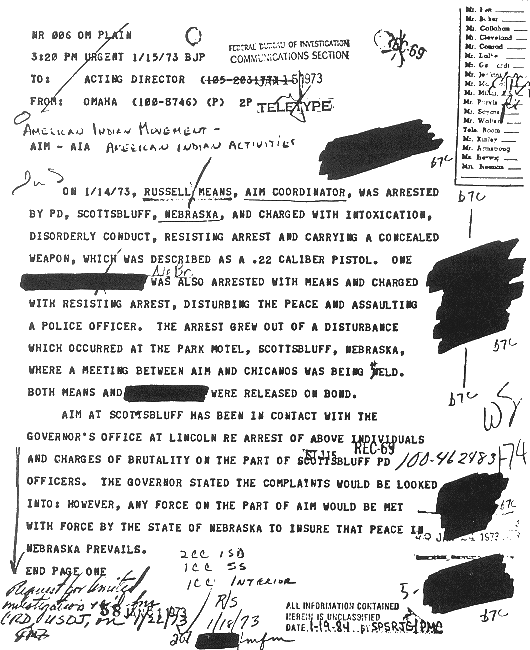
As a result - and in sharp contrast to the massive turnout in Gordon concerning the Yellow Thunder case only a few months before - only about 200 AIM members and supporters turned out to caravan to Custer. 32 Once there, they were confronted by an equal number of riot-equipped local police and county deputies, a state riot squad, representatives of the South Dakota Division of Criminal Investigation and the FBI. 33 Although county officials had agreed to an open meeting with the Indian community, they now insisted they would meet with only Banks, Means and Utah AIM leader Dave Hill (Choctaw); although the courthouse was a public building, the remainder of the group was not allowed inside, and was forced to remain outdoors in a heavy blizzard. The AIM leaders found prosecutor Gates to be adamantly against upgrading the charges. After insisting that justice was already being done, he declared the meeting at an end and told the AIM delegation to leave. When they refused, police attempted to forcibly evict them and a melee broke out which quickly spread to the crowd waiting outside as riot police attacked them with clubs and tear gas. The courthouse and nearby chamber of commerce building were set ablaze by teargas cannisters and 27 Indians were arrested on charges such as "incitement to riot." Among those beaten by police and arrested was Sarah Bad Heart Bull, the victim's mother. She ultimately served five months in jail on charges resulting from the Custer police assault, while her son's murderer never served a day. 34
The violence and perversion of justice directed at the AIM group in Custer did not result from happenstance or mere "overreaction" on the part of local officials. As shown in the accompanying excerpt from a January 31, 1973 teletype sent to FBI headquarters by Minneapolis SAC Joseph Trimbach, the Rapid City office was by this point actively coordinating the activities of state and local police, state's attorneys in western South Dakota, and agents of the Bureau of Alcohol, Tobacco and Firearms (BATF), with regard to "AIM activities." The excerpted teletype also demonstrates that local police - with full knowledge of the FBI - had stonewalled U.S. Justice Department Community Relations Service representatives who were attempting to defuse the situation because the latter "appeared to favor AIM's cause." By early 1973 the Bureau had, with the enthusiastic cooperation of area police, set out to effect the physical repression of AIM while deliberately squelching attempts from both governmental and dissident quarters - to achieve peaceful resolution of the racial/political conflicts around Pine Ridge, and elsewhere in Indian Country.
The smoke and tear gas had barely cleared from the streets of Custer when the next round of confrontation between AIM and the federal government began. This time the locus of activity centered on Pine Ridge itself, and concerned a struggle between the "progressive" administration of the Oglala Sioux tribal president, Dick Wilson - who had already imposed an illegal ban on AIM members speaking or participating in meetings within what he apparently considered to be his private domain - and grassroots Indians on the reservation. Wilson, who had already held an office and been accused of having used the position to embezzle tribal funds, had been ushered into office with substantial government support in 1972. 35 Almost immediately, he had been bestowed with a $62,000 BIA grant for purposes of establishing a "tribal ranger group" - essentially his own private army - an entity which designated itself as "Guardians of the OgIala Nation" (GOONs or GOON Squad). 36 The Indian bureau also allowed him to hire his relatives into the limited number of jobs available through the tribal government, as well as to divert the virtual entirety of the tribal budget into support for his immediate followers rather than the Oglala Lakota people as a whole. 37 When traditionalist Oglalas complained, Wilson dispatched his GOONs. When victims attempted to seek the protection of the BIA police, they quickly discovered that perhaps a third of its roster - including its head, Delmar Eastman (Crow), and his second-in-command, Duane Brewer (OgIala) - were doubling as GOON leaders or members. 38 For their part, BIA officials - who had set the whole thing up -consistently turned aside requests for assistance from the traditionals as being "purely internal tribal matters," beyond the scope of BIA authority.
Exerpt from a January 31, 1973 teletype falsely suggesting AIM was equipping itself with automatic weapons and delineating FBI collaboration with South Dakota police in preparing for AIM's arrival in Custer.
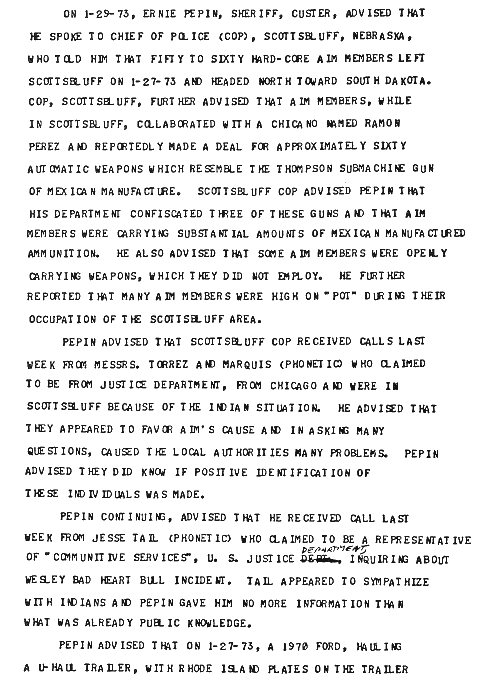
By mid-year, the quid pro quo attending federal support to the regime emerged. In exchange for being allowed to run Pine Ridge as a personal fiefdom, Wilson was to sign over title to the northwestern one-eighth of the reservation - an area known as the Sheep Mountain Gunnery Range - to the National Park Service (which, like the BIA, is part of the Department of Interior). 39 Thus faced not only with Wilson's continued financial malfeasance and outright terrorizing of opponents, but with a significant loss of their already truncated landbase as well, the traditionals attempted to avail themselves of their legal right to impeach the corrupt official. The BIA responded by naming Wilson to serve as chair of his own impeachment proceedings, and the Justice Department dispatched a 65-member U.S. Marshals Special Operations Group (SOG) to Pine Ridge, to "maintain order." 40 Under such circumstances, Wilson was able to maintain his position when he finally allowed the impeachment vote to be taken on the afternoon of February 23, 1973. The same evening, he proclaimed a reservation-wide ban on any further political meetings. 41
On February 24, more than 200 people - including most of the traditional Oglala chiefs - defied the meeting ban to assemble at the Calico Hall (north of Pine Ridge village). They vowed to continue meeting until "something was done about Dickie Wilson." At their request, Russell Means traveled from Rapid City to meet with the Calico Hall group; he then attempted to meet with Dick Wilson to discuss the traditionals' grievances. 42 The meeting was aborted when Means was attacked in the parking lot outside tribal headquarters by several of Wilson's GOONs. 43 When Justice Department Community Relations official John Terronez (incorrectly referred to in the excerpted January 31 teletype as Torrez) attempted to go through the marshals to arrange a parlay between the traditionals and Wilson, the head of the SOG unit, Reese Kash, instructed his subordinates to "inform Mr. Terronez that CP [Command Post] was unable to contact me." 44
Attempts at negotiation having failed, the Calico Hall group decided on the evening of February 27 to join forces with AIM and caravan to the hamlet of Wounded Knee, about 15 miles east of Pine Ridge village. They intended to remain overnight in a local church and hold a press conference at this symbolic location the following morning. 45 They had agreed to release a statement demanding congressional hearings on the actions of the Wilson government, as well as treaty rights and BIA abuses generally. Ted Means and other AIM representatives were assigned to notify the media and coordinate transportation of reporters from Rapid City to the press conference site. However, at dawn on the 28th, those assembled at Wounded Knee found the roads to the hamlet blockaded by GOONs later reinforced by marshals service SOG teams and FBI personnel. 46 By 10 p.m., Minneapolis SAC Joseph Trimbach had flown in to assume personal command of the GOONs/BIA police, while Wayne Colburn, director of the U.S. Marshals Service, had arrived to assume control over his now reinforced SOG unit. Colonel Volney Warner of the 82nd Airborne Division and 6th Army Colonel Jack Potter-operating directly under General Alexander Haig, military liaison in the Nixon White House - had also been dispatched from the Pentagon as "advisors" coordinating an illegal (under provisions of the Posse Comitatus Act; 18 USCS ' 1385) flow of military personnel, weapons and equipment to those besieging Wounded Knee. 47 As Rex Weyler has noted:
Documents later subpoenaed from the Pentagon revealed that Colonel Potter directed the employment of 17 APCs [armored personnel carriers], 130,000 rounds of M-16 ammunition, 41,000 rounds of M-40 high explosive, as well as helicopters, Phantom jets, and personnel. Military officers, supply sergeants, maintenance technicians, chemical officers, and medical teams remained on duty throughout the 71 day siege, all working in civilian clothes [to conceal their unconstitutional involvement in this "civil disorderl"]. 48By 3 a.m. on March 1, the colonels were meeting secretly with Trimbach and Colburn, as well as Colonel Vic Jackson of the California-based Civil Disorder Management School (CDMS), at nearby Ellsworth Air Force Base. 49 Jackson, a specialist in irregular warfare, seems likely to have been brought in to implement of one of two "domestic counterinsurgency scenarios" code-named "Garden Plot" and "Cable Splicer," which CDMS had been created to perfect. 50 By March 3, F-4 Phantom jets were making regular low-level reconnaissance runs over the hamlet, and the outright military nature of the federal buildup had otherwise become obvious. AIM proposed a mutual withdrawal of forces and negotiations, but the government, expressing a clear intent to settle the confrontation by force, declined this offer. 51 On March 5, Dick Wilson - with federal officials present - held a press conference to declare "open season" on AIM members on Pine Ridge, declaring "AIM will die at Wounded Knee." 52 For their part, those inside the hamlet announced their intention to remain where they were until such time as Wilson was removed from office, the GOONs disbanded, and the massive federal presence withdrawn.
Attempts at negotiation during the next few days were consistently rebuffed by government hardliners and, on March 8, AIM was warned that women and children should leave the defensive perimeter. 53 That evening an APC fired on an AIM patrol, wounding two men. 54 This was followed by a firefight on March 9 during which thousands of rounds of automatic weapons fire were poured into the hamlet by federal forces. AIM responded by firing a single magazine of ammunition from their only automatic weapon, a Chinese AK-47 brought home by a returning Vietnam veteran. This led to the circulation of disinformation in the media by FBI "public relations specialists" that the defenders were firing on federal positions with an M-60 machinegun. 55
On the morning of March 11, the government temporarily lifted the siege (over protests by the FBI), apparently hoping its show of force had intimidated AIM into surrendering. Instead, more than 100 supporters streamed into Wounded Knee, bringing with them supplies and weapons. 56 The traditionals also utilized the opportunity to proclaim themselves an "Independent Oglala Nation" (ION), with rights specifically defined within the 1868 Fort Laramie Treaty, entirely separate from the IRA government headed by Dick Wilson. SAC Trimbach, along with several of his men disguised as "postal inspectors," then attempted to enter the hamlet to survey its defenses; detained at the perimeter by AIM security personnel, they were told to leave or be arrested by the ION. 57 His ploy to end the cease fire with a provocation successfully completed, Trimbach immediately used this incident as a basis for reestablishing his portion of the siege lines; faced with a fait accompli, the marshals shortly followed suit. 58 The Minneapolis SAC was reinforced in this course of action by veteran COINTELPRO specialist Richard G. Held, who had been sent to Pine Ridge from his position as SAC in Chicago (where he was even then orchestrating the cover up of the Bureau's role in the Hampton-Clark assassinations; see Chapter 5) to "consult" on the sorts of operations the FBI should undertake against AIM. 59 Trimbach's move was entirely consistent with a string of "reports" Held was at the time sending to headquarters asserting that other law enforcement agencies were not sufficiently tough in dealing with the "insurgents" - a bit of outright counterinsurgency vernacular which stuck, as is evidenced in the accompanying October 31, 1973 predication for investigation - stressing that all police personnel on the reservation should have been placed under direct Bureau control from the outset, and protesting a Justice Department prohibition on "shoot-to-kill" techniques on the siege line. 60 Given that the BIA police (and, by extension, the GOONs) had all along come under command of the FBI, these remarks could only have been directed at the U.S. Marshals Service.
Probably the most immediate result of Held's and Trimbach's renewed siege was the precipitation of a firefight on the afternoon of March 12, in which SA Curtis Fitzpatrick was wounded slightly, in the wrist. Bureau propagandists seized the opportunity to engage in an incredible bit of theatrics, arranging for Fitzpatrick to be "med-evacked" by military helicopter to Ellsworth Air Force Base, where a full complement of media personnel had been assembled to see him arrive with his head swathed in bandages. 61 Simultaneously, an active campaign to "develop informants" and infiltrate provocateurs within Wounded Knee was under way. Among the former was Leroy Little Ghost, (Hunkpapa Lakota) from the Fort Totten Reservation in North Dakota, who was recruited with the guarantee of $2,000-20,000 (depending on how well he did) in cash for his services. 62 Among the latter were Gi and Jill Shafer, withdrawn by the Bureau from running the bogus "Red Star Collective" in the South to serve as volunteer "medics" within the besieged hamlet. 63 Another provocateur sent into Wounded Knee by the FBI during this period was Douglass Durham - a former CIA operative, police officer, affiliate of organized crime in the Midwest and suspected murderer - who posed as a "part-Minneconjou Lakota" (at other times "part-Chippewa") and reporter for the radical Iowa periodical Pax Today. 64 The Bureau was also, as the accompanying excerpt from a teletype concerning KIXI radio reporter Clarence McDaniels makes clear, using media personnel as intelligence agents, both with and without their knowledge.
Predication for an investigation of the American Indian Movement. Note adoption of the vernacular of counterinsurgency warfare.
Meanwhile, the policy conflict between the FBI (and its BIA police/GOON surrogates) on one side and the U.S. Marshals Service and military on the other was sharpening. As the FBI's role in the siege increased under Richard Held's tutelage, so did the intensity of firefights and GOON depredations. Beginning on March 13, federal forces directed fire from heavy .50 caliber machineguns into the AIM positions, greatly increasing the probability of lethal injury to those inside. The following month was characterized by alternating periods of negotiation, favored by the army and the marshals - which the FBI and GOONs did their best to subvert - and raging gun battles when the latter held sway. Several defenders were severely wounded in a firefight on March 17, and on March 23 some 20,000 more rounds were fired into Wounded Knee in a 24-hour period. 65 During the latter, the government forces suffered their only serious casualty when a marshal, Lloyd Grimm, was struck in the torso by a .30 caliber slug (probably fired by a GOON) and paralyzed. 66 Apparently with the intent of denying even biased first-hand coverage of the events, and in anticipation of another escalation in hostilities, the FBI banned further media access to the Wounded Knee area; on the day Grimm was hit, the Bureau announced that reporters who continued to report from inside the AIM/ION perimeter would face federal indictments when the siege ended. 67 At about the same time, the Bureau announced that anyone found attempting to bring supplies into Wounded Knee would be arrested on charges such as "conspiracy to abet a riot in progress." 68
Excerpt from teletype describing manipulation of news content and use of suppressed stories of reporter Clarence McDaniels as intelligence source, apparently without his knowledge.
On April 6, AIM, ION and government moderates mustered another serious attempt to avoid further bloodshed, reaching a cease-fire agreement and the basis for a negotiated settlement. 69 The agreement was, however, violated by the government within 72 hours of its signing and the siege continued. 70 Consequently, on April 17, the government fired more than 4,000 rounds into the village, much of it .50 caliber armor-piercing munitions. Frank Clearwater (Apache) from North Carolina, was fatally wounded in the back of the head by one of these heavy slugs as he lay sleeping in the hamlet church; he died on April 25. Five other AIM members were wounded less seriously. 71
The FBI's "turf battle" with the "soft" elements of the federal government rapidly came to a head. On April 23, Chief U.S. Marshal Colburn and federal negotiator Kent Frizzell (a solicitor general in the Justice Department) were detained at a GOON roadblock and a gun pointed at Frizzell's head. By his own account, Frizzell was saved only after Colburn leveled a weapon at the GOON and said, "Go ahead and shoot Frizzell, but when you do, you're dead." 72 The pair were then released. Later the same day, a furious. Colburn returned with several of his men, disarmed and arrested eleven GOONs, and dismantled the roadblock - However, "that same night... mom of Wilsons people put it up again. The FBI, still supporting the vigilantes, had [obtained the release of those arrested and] supplied them with automatic weapons." 73 The GOONs were being armed by the FBI with fully automatic M-16 assault rifles, apparently limitless quantifies of ammunition, and state-of-the-art radio communications gear. When Colbum again attempted to dismantle the roadblock:
FBI [operations consultant] Richard [G.] Held arrived by helicopter to inform the marshals that word had come from a high Washington source to let the roadblock stand ... As a result the marshals were forced to allow several of Wilson's people to be stationed at the roadblock and to participate in ... patrols around the village. 74On the evening of April 26, the marshals reported that they were taking automatic weapons fire from behind their position, undoubtedly from GOON patrols. The same "party or parties unknown" was also pumping bullets into the AIM/ION positions in front of the marshals, a matter which caused return fire from AIM security. The marshals were thus caught in a crossfire. 75 At dawn on the 27th, the marshals, unnerved at being fired on all night from both sides, fired tear gas cannisters from M-79 grenade launchers into the AIM/ION bunkers. They followed up with some 20,000 rounds of small arms ammunition. AIM member Buddy Lamont (Oglala), driven from a bunker by the gas, was hit by automatic weapons fire and bled to death before medics, pinned down by the ban-age, could reach him. 76When the siege finally ended through a negotiated settlement on May 7, 1973, the AIM casualty count stood at two dead and fourteen seriously wounded. An additional eight-to-twelve individuals had been "disappeared" by the GOONs. They were in all likelihood murdered and - like an untold number of black civil rights workers in swamps of Mississippi and Louisiana - their bodies secretly buried somewhere in the remote vastness of the reservation. 77
Wounded Knee marked the beginning rather than culmination of the FBIs campaign against AIM and its allies on Pine Ridge. As the military advisers and Colburn's marshals were withdrawn the FBI was now free of their scrutiny. The Bureau beefed up its Rapid City resident agency (within which area of responsibility the reservation falls) to fill in behind them. Although Richard G. Held returned to his post in Chicago, the tactical groundwork he had laid during the siege - a matter partially illuminated in the accompanying report, "The Use of Special Agents in Paramilitary Law Enforcement Operations in the Indian Country," which he wrote at the time but which was not generally disseminated until April 24, 1975 (under the signature of J.E. OConnell) - supported counterinsurgency war on Pine Ridge over the next three years.
Blood of the Land: The government and Corporate War Against the American Indian Movement, Rex Weyler,p.80
During the 36 months roughly beginning with the end of Wounded Knee and continuing through the first of May 1976, more than sixty AIM members and supporters died violently on or in locations immediately adjacent to the Pine Ridge Reservation. A minimum of 342 others suffered violent physical assaults. 78 As Roberto Maestas and Bruce Johansen have observed:Of these 60-plus murders occurring in an area in which the FBI held "preeminent jurisdiction," not one was solved by the Bureau. In most instances, no active investigation was ever opened. The same is true for the nearly 350 physical assaults, despite eye-witness identification the killers and assailants who in each instance were known members of the Wilson GOON Squad. When confronted with the magnitude of his office's failure to come to grips with the systematic slaughter which was going on within its area of operations, Rapid City ASAC George O'Clock pleaded 'lack of manpower" as a cause. 80 Yet O'Clock's office, which was customarily staffed with three agents before Wounded Knee, grew by nearly 300% - to eleven agents - during the first six months of 1973. 81 In March of that year, this force was doubled, augmented by a ten-member FBI SWAT unit to the tiny village of Pine Ridge, on the reservation itself. 82 This aggregate force of 21 was maintained for more than two years, until it was tripled during June and July of 1975, affording the Rapid City office with the heaviest sustained concentration of agents to citizens in the history of the Bureau. 83Using only these documented political deaths, the yearly murder rate on Pine Ridge Reservation between March 1, 1973, and Mardi 1, 1976, was 170 per 100,000. By comparison, Detroit, the reputed "murder capital of the United States," had a rate of 20.2 in 1974. The U.S. average was 9.7 per 100,000, with the range for large cities as follows: Detroit, 20.2; Chicago, 15.9; New York City, 163; Washington, D.C, 13.4; Los Angeles, 12.9; Seattle, 5.6; and Boston, 5.6. An estimated 20,000 persons were murdered in the United States in 1974. In a nation of 200 million persons, a murder rate comparable to that of Pine Ridge between 1973 and 1976 would have left 340,000 persons dead for political reasons in one year; 1.32 million in three. A similar rate for a city of 500,000 would have produced 850 political murders in a year, 2,550 in three. For a metropolis of 5 million the figures would have been 8,500 in one year and 25,500 in three ... The political murder rate at Pine Ridge between March 1, 1973, and March 1, 1976, was almost equivalent to that in Chile during the three years after the military coup supported by the United States deposed and killed President Salvador Allende ... Based on Chiles population of 10 million, the estimated fifty thousand persons killed in three years of political repression in Chile at the same time (1973/1976) roughly paralleled the murder rate at Pine Ridge. 791975 expanded version of COINTELPRO specialist Richard G. Held's 1973 field notes taken at Wounded Knee insisting that thenceforth the FBI would assume immediate and absolute control over "paramilitary operations in Indian Country." Note strenuous objection raised concerning official "shoot to wound" orders.While claiming to lack the resources to investigate the literal death squad activity occurring beneath his nose, O'Clock managed to find the wherewithal to compile more than 316,000 separate investigative file classifications on AIM members with regard to the siege of Wounded Knee alone. 84 His agents also found the time and energy to arrest 562 AIM members and supporters for participation in the siege, while another 600 individuals across the nation were charged for supporting the defenders. 85 These 562 arrests resulted in the indictments of 185 persons, many on multiple charges (none involving a capital crime). In the two years of trials which followed, there were a total of fifteen convictions - mostly on minor charges - an extraordinarily low rate for federal prosecutions. 86 As Colonel Volney Warner later put it, "AlM's most militant leaders are under indictment, in jail or warrants are out for their arrest ... the government can win, even if no one goes to jail." 87
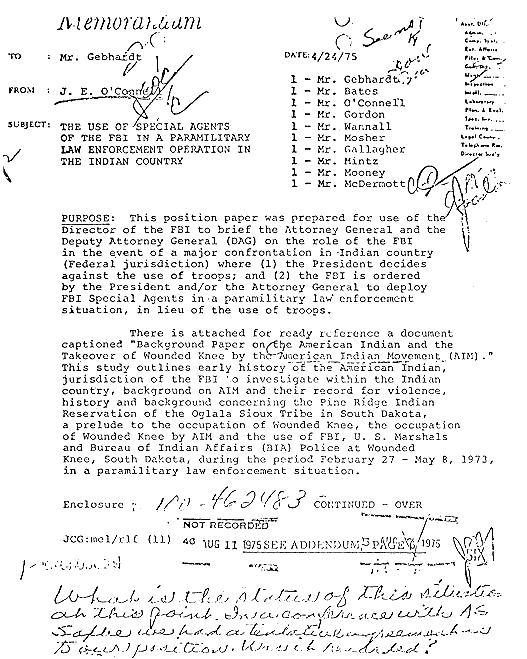
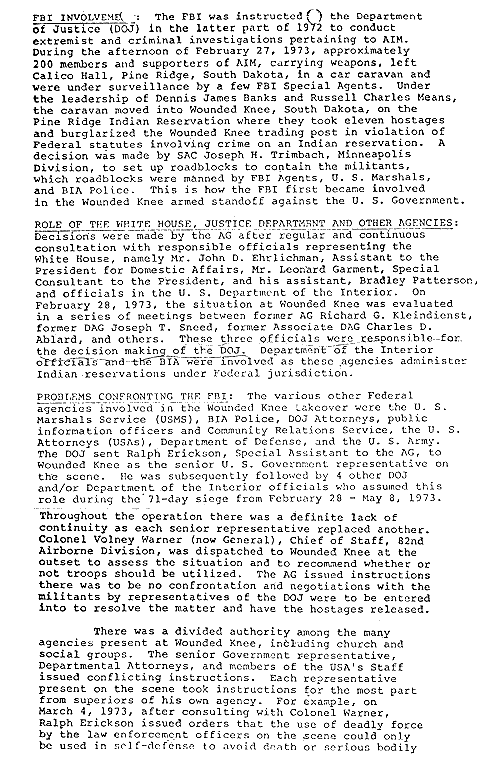
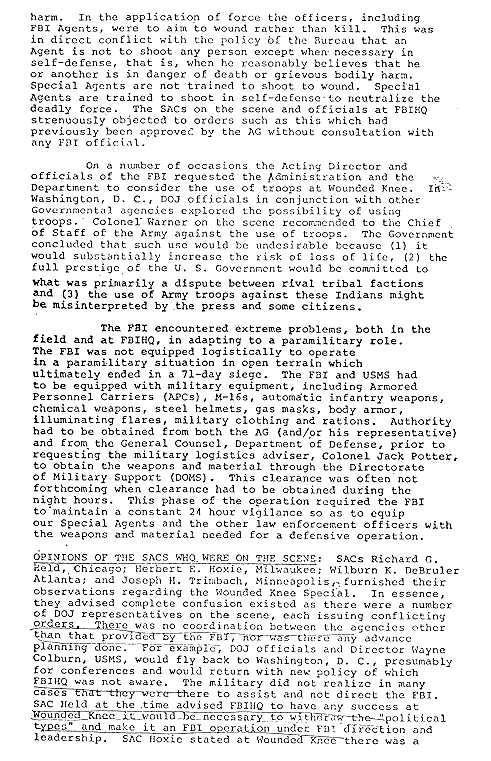
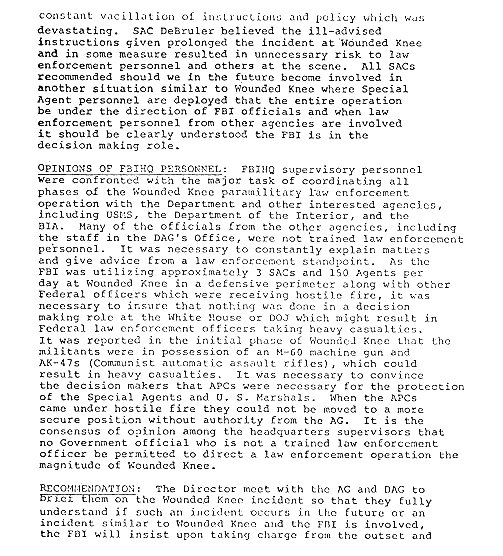
Although the Wounded Knee Legal Defense/Offense Committee (WKLDOC) - a largely non-Indian coalition of attorneys established by National Lawyers Guild activist Ken Tilsen to represent AIM in criminal proceedings undertaken against its members and leadership - formally challenged U.S. jurisdiction over the Pine Ridge Reservation, the government forged ahead with the prosecution of those it considered "key AIM leaders." 88 Indicative of the quality of justice involved in these "Wounded Knee Leadership Trials" was that of Russell Means and Dennis Banks before District Judge Fred Nichol during 1974. Based on an FBI "investigation," the defendants were charged with 13 offenses each, including burglary, arson, possession of illegal weapons, theft, interfering with federal officers and criminal conspiracy; cumulatively, each faced more than 150 years in prison as a result. 89The crux of the case was the "eyewitness" testimony of a young Oglala named Louis Moves Camp-whom Banks had earlier expelled from AIM due to his persistent misconduct - concerning the AIM leaders' actions inside Wounded Knee. The case collapsed when the defense established that Moves Camp was testifying about events allegedly occurring in South Dakota at a time when he had been on the west coast. 90
But that was hardly all that was wrong with the federal case. Moves Camp had been recruited as a witness by David Price and Ronald Williams, two agents recently assigned to the Rapid City FBI office. 91 His participation as a prosecution witness was apparently obtained in exchange for a "deal" concerning charges of robbery, assault with a deadly weapon (two counts) and assault causing bodily harm (two counts) - adding up to a possible 20-year sentence-facing him in South Dakota. 92 He was also paid by the Bureau for his services. 93 Further, while staying at a resort in Wisconsin with SAs Price and Williams, awaiting his turn to testify against Means and Banks, Moves Camp appears to have raped a teenaged girl in nearby River Falls; after meeting for several hours with local police, Agent Price was able to fix this charge as well. 94 Minneapolis SAC Joseph Trimbach refused to allow prosecutor R.D. Hurd to administer a polygraph examination to Moves Camp prior to putting him on the stand; 95 Hurd lied to the court, asserting that the River Falls situation was "only a minor matter," such as "public intoxication." 96 Then it came out that the FBI and prosecution had-despite the filing of proper discovery motions by the defense deliberately suppressed at least 131 pieces of exculpatory evidence which might have served to exonerate the defendants. 97 With this magnitude of government misconduct on the record, Judge Nichol responded by dismissing an charges against Means and Banks. In his decision, the judge observed that it was difficult for him to accept that "the FBI [he had] revered so long, [had] stooped so low," and:
Although it hurts me deeply, I am forced to the conclusion that the prosecution in this trial had something other than attaining justice foremost in its mind ... The fact that the incidents of misconduct formed a pattern throughout the course of the trial leads me to the belief that this case was not prosecuted in good faith or in the spirit of justice. The waters of justice have been polluted, and dismissal I believe, is the appropriate cure for the pollution in this case. 98The dismissal of charges occurred before it became known that, contrary to Hurd's and Trimbach's sworn testimony, the FBI had infiltrated Banks' and Means' defense team. 99 The operative used for this purpose was Douglass Durham, then AIM's national security director and Dennis Banks' personal bodyguard. In this capacity, Durham attended all the defense team's meetings (enabling him to report their strategy to the FBI, thence to prosecutors), and exerted near-total control over the defendants' office ("Nobody saw Banks or Means without going through me. Period."). 100
[Ed.Note: a common tactic to isolate and control information and funds]He also maintained free access to defense funds, from which he is suspected of having embezzled more than $100,000 during the course of the trial. 101 Far from the Bureau's having been unaware of the "problem," FBI records reveal that Durham met with his handlers, SAs Ray Williams and Robert Taubert, "regularly" and was given a raise because of the quality of his services during the trial. 102
Such behavior on the part of the prosecution and the FBI might be considered anomalous were it true that Hurd was brought up on ethics charges before the American Bar Association (as Judge Nichol clearly desired), Louis Moves Camp charged with perjury, Trimbach removed from his position as SAC and the involved agents at least reprimanded, and Durham's undercover operation suspended. It was Nichol, however, who was removed from trying any further AIM-related cases. 103 Nothing at all was done to Moves Camp. 104 Far from being disbarred, R.D. Hurd was promoted and received an award for his performance, and was assigned a lead role in seeking convictions against other AIM leaders, such as Stan Holder, Carter Camp and Leonard Crow Dog. 105Trimbach and his agents continued in their positions with no official censure, while spearheading the Bureau's anti-AIM campaign on Pine Ridge. 106 For his part, Douglass Durham remained in his capacity as a provocateur within AIM until the organization itself discovered his true identity. 107 Before this occurred, he played a leading role in the perversion of justice attending the notorious Skyhorse/Mohawk case in southern California. 108 After his exposure, he is thought to have been involved in the violent elimination of at least one of the witnesses to his grossly illegal "investigative techhiques," 109 and - still on the FBI payroll - served as the sole witness before the Senate Subcommittee on Internal Security, "establishing" that AIM was a "violent revolutionary organization." 110
These results are consistent with a Bureau thrust, revealed in the accompanying May 4,1973 teletype from the Los Angeles field office to Acting Director L. Patrick Gray, even before the Wounded Knee siege had ended, in which agents were busily concocting all manner of allegations concerning AIM's acquisition of "automatic weapons, bazookas, rocket launchers, hand grenades, land mines, and mortars" (none of which ever materialized). As the document makes clear, the compilation of such "information" was intended as a means of securing Gray's authorization to undertake to divide AIM from major funders such as Sammy Davis, Jr. It is instructive that in the same document there is an attempt to link AIM directly to the LA chapter of the Black Panther Party, against which similar methods and rationales had long been utilized as part of COINTELPRO-BPP (see Chapter 5). Such techniques couple nicely to the accompanying May 4,1973 Airtel from Gray to his SAC, Albany, which recommends employment of typical counterintelligence measures against AIM and inclusion of AIM leaders in the Bureau's Administrative Index as "Key Extremists."
Excerpts from May 1973 teletype itemizing never-substantiated arms acquisitions by AIM and detailing COINTELPRO type operation to deny the organization funding from Sammy Davis, Jr.Far more explicit was a November 26,1973 teletype from SA Richard Wallace Held's counterintelligence group in Los Angeles - which had handled the lethal repression visited upon the LA-BPP - to Gray, suggesting that "Los Angeles and Minneapolis consider possible COINTELPRO measures to further disrupt AIM leadership." 111 This leaves little doubt that counterintelligence specialists such as the younger Held continued to view their job assignments vis 4 vis AIM in precisely the same terms as they had with regard to organizations such as the BPP two years earlier, even if headquarters had in the meantime forbidden use of the customary vernacular. In a superficial exercise in "plausible deniability" the acting director replied in a December 4 teletype:
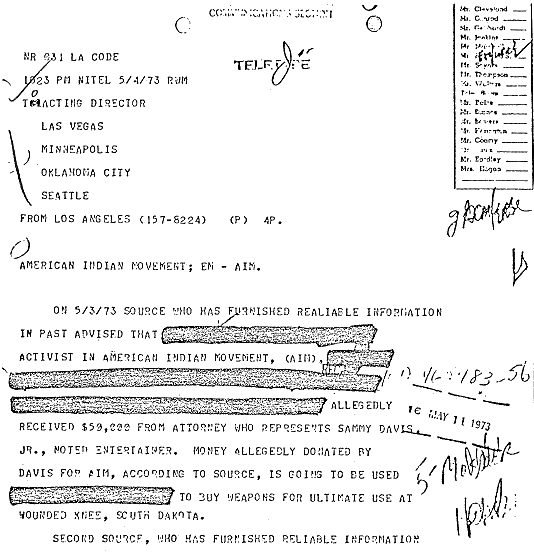
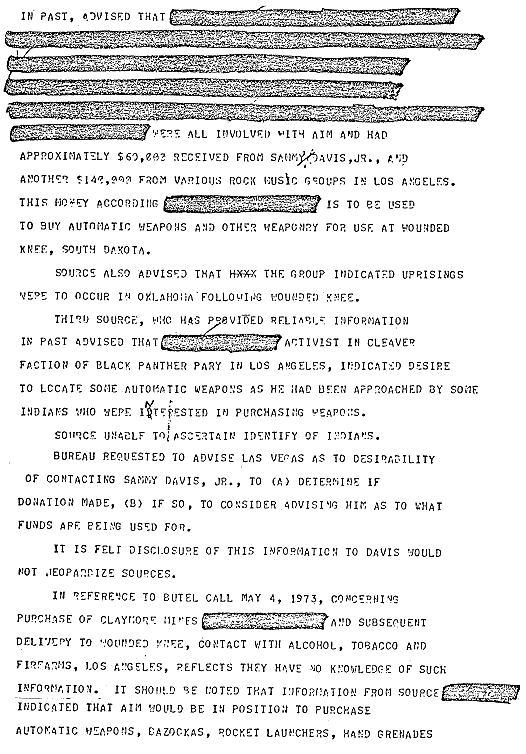
What seems to have been at issue was Held's telltale use of terminology rather than the sort of tactics he was recommending. Indeed, as Bureau conduct in its use of Douglass Durham and the nature of its other involvement in the Banks/Means trial readily indicate, there is every indication that the FBI had already adopted the methods Held advocated for use against AIM.Los Angeles suggested that there appears to be a split between Means and Banks based on [deleted's] dismissal from AIM and suggested possible counterintelligence measures be taken to further disrupt AIM leadership ... Your attention is directed to Bureau airtel to All Offices, dated 4/28/71, captioned "Counterintelligence Programs; IS - RM," setting forth that effective immediately all counterintelligence programs operated by the Bureau were being discontinued." 112As was noted above, a far more striking example of this than the utilization of agents provocateurs, disinformation and legal fabrications to neutralize AIM was the Bureau's reliance upon Wilson's GOON Squad to decimate the ranks of organizational members and supporters on Pine Ridge. Deployed in much the same fashion as appears to have been intended for the SAO by Held's LA COINTELPRO Section during 1971 and '72 (see Chapter 6), the GOONs functioned essentially as a reservation death squad. Among their first victims was Pedro Bissonette, the young head of the grassroots OgIala Sioux Civil Rights Organization (OSCRO), who had emerged as an ION leader at Wounded Knee. In the aftermath of the siege, the FBI had offered Bissonette a "deal" wherein all charges would be dropped against him in exchange for his testifying against the AIM leadership. 113
He refused, and countered that it was his intention to testify instead to the specifics of the graft and corruption permeating the Wilson administration, and the role of the government in perpetuating the situation. Subsequently, he was accosted by a GOON named Cliff Richards in the reservation-adjacent hamlet of White Clay, Nebraska on the afternoon of October 17, 1973. In the ensuing scuffle, Bissonette knocked his attacker to the ground, then got in his car and drove away. 114Although White Clay is outside BIA police jurisdiction, Pine Ridge police/ GOON head Delmar Eastman immediately mobilized his entire force - assisted by several FBI spotter planes - in a reservation-wide manhunt for the "fugitive." 115 At some point between 9 and 9:50 p.m. the same evening, Bissonette was stopped at a roadblock near Pine Ridge village and shot in the chest by a BIA police officer (and known GOON) named Joe Clifford. In Clifford's official report, he had been forced to shoot the victim, who had resisted arrest, jumping from his car brandishing a weapon. He recorded that he'd used a 12-gauge shotgun and that the shooting occurred at 9:48 p.m. Bissonette was pronounced dead on arrival at the Pine Ridge hospital at 10:10 p.m." 116 No weapon attributable to Pedro Bissonette was ever produced by the police. Several witnesses who drove by the scene, however, later submitted affidavits that a pool of blood indicating that Bissonette had already been shot was evident at shortly after 9 p.m., suggesting that the GOONs had delayed the victim's transport by ambulance to the nearby hospital (and medical attention) for approximately an hour, until he bled to death. 117
May 1973 teletype initiating a nation-wide, "forceful and penetrative interview program," of all individual AIM activists with an eye toward their designation as "Key Extremists." Note similarity to earlier COINTELPRO practice of convincing new left activists there was "an agent behind every mailbox."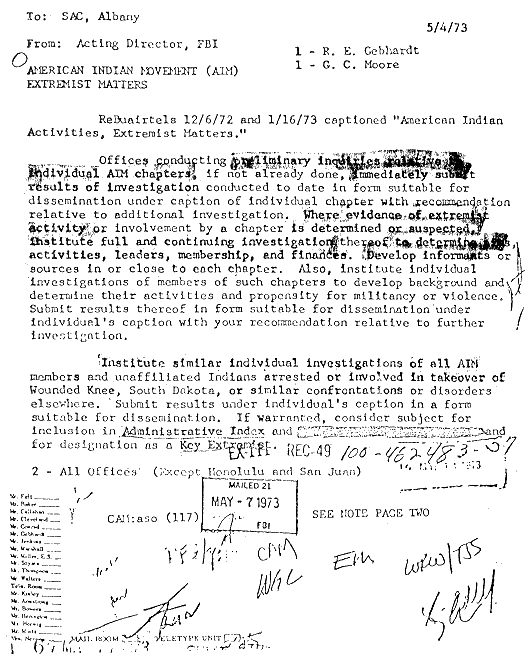
Moreover, when WKLDOC attorney Mark Lane viewed the corpse in the hospital morgue at around midnight, he discovered that rather than having suffered a shotgun blast, Bissonette appeared to have been shot seven times with an "approximately .38 calibre handgun" in the chest. The shots, "any one of which might have killed him," were placed in a very tight cluster, Lane insisted, as if they'd been fired at point-blank range." 118 The attorney also recounted that it appeared Bissonette had been beaten prior to being shot. 119 He therefore quickly called Gladys Bissonette*, the dead man's grandmother, and convinced her to demand an independent autopsy be performed. She agreed. Lane then phoned Assistant U.S. Attorney Bill Clayton in Rapid City, to notify him of the family's intent to pursue its legal right to commission such an autopsy. Clayton appears to have immediately called Delmar Eastman and instructed him to remove the body from the morgue at 3 a.m. - and have it transported, not only off the reservation, but out of the state, to Scottsbluff, Nebraska. 120 There, W.O. Brown, a government-contracted coroner, dissected the body, turned over whatever slugs he recovered to the FBI and reached a conclusion corroborating Clifford's version of events. There was little left of the corpse for an independent pathologist to examine. 121 Despite the controversy swirling around Bissonette's death, and the existence of witness accounts contradicting the police story, the Bureau pursued no further investigation of the matter. OSCRO collapsed as a viable organization as a direct result of its leader's elimination.
Two years later, with the number of unsolved murders of AIM members and supporters on Pine Ridge having reached epic proportions, 122 and despite Wilson's loss in his third bid for the tribal presidency, the GOONs and their FBI cohorts were still pursuing the same lethal tactics. For instance, in the early evening of January 30, 1976, three cars containing 15 members of the GOON Squad pulled into the tiny hamlet of Wanblee (located in the northeastern sector of the reservation), a strong bastion of anti-Wilsonism. Spotting the car of Byron DeSersa, a young Oglala tribal attorney and AIM supporter who had announced his intention to bring criminal charges against a number of Wilsonites once the regime was disbanded, they gave chase, firing as they went. About four miles out of town, a bullet passed through the driver's-side door of DeSersa's car, catching him in the upper left thigh, nearly amputating his leg. DeSersa pulled over and dragged himself into a ditch, screaming at several friends who had been his passengers to run for their lives. He bled to death alongside the road as the GOONs chased the others through adjoining fields. 123
The GOONs then returned to Wanblee, where they apparently passed a pleasant evening shooting up the homes of those who had opposed Wilson. The following morning, they firebombed several buildings and continued to drive around town taking random potshots. As the Commission on Civil Rights later determined, that afternoon - with the smoke still billowing from the GOONs' incendiary attacks - a pair of FBI agents arrived in Wanblee and were quickly informed by residents as to what had transpired. George Bettelyoun (Oglala), a passenger in DeSersa's car, provided precise identification of the killers, who included Dick Wilson's son Billy and son-in-law, a GOON leader named Chuck Richards. 124 The agents declined to make arrests, stating that they were there in a "purely investigative" capacity. They nonetheless managed to arrest Guy Dull Knife, an elderly Cheyenne who lived in Wanblee; Dull Knife, the agents declared, had disturbed the "peace" by protesting their inaction against the GOONs too loudly. 125 The citizens of Wanblee finally formed a vigilance committee on January 31, giving the marauders until sundown to be gone from their community or suffer the consequences. Delmar Eastman then dispatched a group of BIA police to escort the GOON contingent safely back to Pine Ridge village; again, no arrests were made. The Bureau, as usual, conducted no further investigation into either the DeSersa murder or the firebombings and other aspects of the GOONs' two-day terrorization of the hamlet. 126
Later, while sparring with a congressional committee critical of the Bureau's performance on Pine Ridge during the mid-'70s, FBI Director William Webster was to cast his agents' role there as having been that of "peacekeepers." "Frankly [the Bureau] took ... a little bit of a beating during those days in Wounded Knee period and afterwards," Webster asserted, "[but] our role should be an investigator's role, not a peacekeeper's role." 127 The director's use of the word "peacekeepers" in such a context is illuminating, insofar as this is the standard term in military and police parlance applied to counterinsurgency operatives. 128 The real meaning imbedded in the director's semantics is further revealed in the fact that FBI documents throughout the period in question - such as the accompanying February 6,1976 memorandum from SAC, Portland to Director - openly and consistently refer to dissident Indians as "insurgents." Official protestations to the contrary notwithstanding, the FBI not only undertook a full-fledged COINTELPRO against AIM, it escalated its conceptual and tactical approach to include outright counterinsurgency warfare techniques. Only within this framework can the events discussed above be rendered comprehensible.
"RESMURS"By early 1975, it had become clear to the opposition of Pine Ridge that its attempts to achieve resolution of its grievances through due process - whether by impeachment of Dick Wilson, electing another individual into his office, or the filing of formal civil rights complaints - were being systematically aborted by the very government which was supposed to guarantee them. 129 The FBI and BIA police structures were reinforcing rather than interfering with the pervasive GOON violence. Reservation conditions were being officially described by the U.S. Commission on Civil Rights as a "reign of terror ." 130 The message was unequivocal: the dissidents could either give in and subordinate themselves to Wilson's feudal order, allowing the final erosion of Lakota rights and landbase, or they would have to physically defend themselves and their political activities. Hence Oglala traditionals requested that AIM establish centers for armed self-defense at various points on the reservation.COINTELPRO as counterinsurgency. By 1976 the FBI's misrepresentation of AIM activities was down pat, and its characterization of AIM members as insurgents was standard.During the spring of 1975, the Northwest AIM Group - including Leonard Peltier, Frank Black Horse (adopted Oglala), Bob and Jim Robideau (both Anishinabes), and Darelle "Dino" Butler (Tuni) - set up a defensive encampment at the request of elders Harry and Cecilia Jumping Bull. The camp, was situated in a strongly pro-AIM area, on a property known as the Jumping Bull Compound, near the village of OgIala. It was referred to as "Tent City" in FBI communications, and became an immediate preoccupation of the Bureau and its GOON surrogates. 131 As was noted in a June 6,1975 memorandum captioned "Law Enforcement on the Pine Ridge Indian Reservation:"On the afternoon of June 25, 1975, SAs Ronald Williams and Jack Coler, accompanied by BIA police officers (both Oglalas and known GOONs) Robert Ecoffey and Glenn Little Bird, entered the Jumping Bull Compound, ostensibly searching for a 19-year-old Oglala AIM member, Jimmy Eagle, on what they said were charges of "kidnapping, aggravated assault, and aggravated robbery." 134 When they were told Eagle wasn't there and hadn't been seen in weeks, they left, but shortly picked up three Dine (Navajo) teenagers from the AIM camp - Norman Charles, Wilfred 'Wish" Draper and Mike "Baby AIM" Anderson - hitchhiking along Highway 18, which runs between Oglala to Pine Ridge village. Williams and Coler questioned the three, not about Eagle, but about who else was residing in Tent City. The three were then released and returned to camp. 135
Before mid-moming, June 26, local residents knew that something ominous was in the offing. Indians in and around the village of Oglala noted large numbers of paramilitary personnel - GOONs, BIA police, state troopers, U.S. Marshals, and FBI SWAT teams - massing in the area. 136 Around 11:30 a.m. SAs Coler and Williams returned to the Jumping Bull property. They were allegedly sent to serve an arrest warrant on Jimmy Eagle. However, it is clear they'd already ascertained he was not there and, in any event, the warrant for his arrest was not issued till July 7. 137 The agents drove past the buildings of the compound proper and directly toward the AIM camp. They stopped their cars, got out, and began firing their weapons. Members of the camp, believing themselves to be under attack from GOONs, returned fire. 138 This was apparently the cue for the prepositioned reinforcements to arrive; radio transmission logs from SA Williams indicate that he and his partner expected reinforcements to be immediate and massive once the firefight had been initiated.139 Unfortunately for them, three teenagers who had been breakfasting in the compound quickly positioned themselves to cover the route intended by the relief force. 140 Using .22 caliber squirrel rifles, the youngsters shot out the tires of the first two backup cars - driven by SA J. Gary Adams and Fred Two Bulls, a BIA policeman and known GOON. Confronted with these meager potshots, Adams and Two Bulls promptly retreated, abandoning Coler and Williams. 141 Not until 6 p.m., when federal forces had swelled to over 250 men, including a SWAT unit airlifted in from the Bureau's training facility at Quantico, Virginia, and a vigilante force headed by South Dakota Attorney General William Janklow, 142 did the FBI finally mount an assault. 143 By this point, Williams and Coler were long since dead, and the Indians who had been in the AIM camp that morning had - other than a Coeur D'Alene named Joe Stuntz Killsright who had been killed, ostensibly by a long range shot fired by BIA police officer Gerald Hill 144 - made their escape.
Although the deaths of Coler and Williams were probably an unintended consequence, the provocation of the firefight achieved its intended objective: the public justification for a truly massive paramilitary assault on AIM and the Pine Ridge traditionals. As is shown in the accompanying memo from R.E. Gebhardt to J.E. O'Connell, dated June 27,1975, the FBI's top COINTELPRO specialist, Richard G. Held - assigned as the Bureau's Chicago SAC, but already prepositioned in Minneapolis - immediately assumed control over the RESMURS ("Reservation Murders") investigation. Among those accompanying Held to South Dakota was "public information specialist" Tom Coll who immediately undertook a series of sensational press conferences in which he pronounced that the agents had been "lured into an ambush" by AIM and attacked from a "sophisticated bunker complex" where they were wounded and "dragged from their cars" before being "riddled" by "15-20 rounds each" from "automatic weapons." In Coll's accounts, Williams and Coler died while disabled and "begging for their lives." Both agents were "stripped," as part of their "executions," according to Coll. 145 Although literally none of this was true - a matter well known to Bureau investigators at least a day before the first press conference presided over by Tom Coll - such stories produced the lurid headlines necessary to condition public sentiment to accept virtually anything the FBI wished to impose upon AIM. 146 An additional advantage of Coll's media ploy was that it caused a senate select committee planning to investigate those FBI operations already directed against AIM to be indefinitely postponed, "under the circumstances. " 147 It was a week before FBI Director Clarence Kelley quietly "corrected" this welter of disinformation, offered in the finest COINTELPRO style. 148
Another star performer the Chicago SAC brought along was Norman Zigrossi, a young counterintelligence protege whose mission it was to replace ASAC George O'Clock in Rapid City for the duration of the anti-AIM campaign. 149 The elder Held's son, Los Angeles COINTELPRO section head Richard W., was also involved in RESMURS from the outset, as is evidenced in the accompanying June 27,1975 memo from O'Connell to Gebhardt. As is revealed in the accompanying July 26 memo, he had by that date joined his father at Pine Ridge, a locale in which the experience he had acquired while heading the Bureau's counterintelligence campaign against the LA-BPP (see Chapter 5) could be deployed against AIM, and his background overseeing SAO attacks against the left in southern California (see Chapter 6) might be used in connection with the GOONs. Actually, the younger Held probably arrived in South Dakota earlier, as is evidenced by the fact that RESMURS com munications - such as the accompanying June 30, 1975 memo from B.H. Cook to Gebhardt - suddenly adopted the practice of referring to Richard G. Held as "Dick" in order to distinguish him from his namesake.
Memo assigning COINTELPRO specialist Richard G. Held, at the time Chicago SAC, to head up the RESMURS investigation. He had been prepositioned in Minneapolis.The sorts of operations this stable of COINTELPRO aces had in mind had become apparent as early as June 27, when a task force of at least 180 SWAT-trained agents, supported by significant numbers of GOONs/BIA police and a scattering of federal marshals, began running military-style sweeps across Pine Ridge. 150 Outfitted in Vietnam-issue jungle fatigues, and equipped with the full panoply of counterinsurgency weaponry - M-16 assault rifles, M-14 sniper rifles, M-79 grenade launchers, plastic explosives, Bell UH-1B "Huey" helicopters, fixed-wing "Bird Dog" spotter planes, jeeps, armored personnel carriers, army-supplied communications gear and tracking dogs - this huge force spent nearly three months breaking into homes and conducting warrantless searches. 151 Their activities included outright air assaults upon the property of AIM member Sylvester "Selo" Black Crow near Wanblee (on July 8), and Crow Dog's Paradise (on September 5 . 152 On July 12, an elderly resident of Oglala, James Brings Yellow, was frightened into a fatal heart attack when a group of agents led by J. Gary Adams suddenly kicked in his door for no apparent reason 153 With that, virtually the entire Oglala community - AIM and non-AIM alike - launched a petition drive demanding the FBI withdraw from Pine Ridge, and even the typically prostrate Sioux tribal councils endorsed the position. 154 The Bureau's July performance on Pine Ridge was such that the chairman of the U.S. Civil Rights Commission, Arthur J. Flemming, characterized what was happening as "an over-reaction which takes on aspects of a vendetta ... a full scale military type invasion." He went on to say:"All in the family." Memo showing participation of COINTELPRO specialist Richard W. Held, son of Richard G. Held, in the RESMURS investigation from its earliest moments.
Memo showing Richard W. Held's presence on Pine Ridge as a supervisor at the peak of the RESMURS-related repression. The younger Held's "caliber in such a capacity was no doubt proven by his earlier leadership of COINTELPRO-BPP in Los Angeles.
Memo referring to Richard G. Held as "Dick" to distinguish him from his son during their joint participation in RESMURS. Note also the Bureau's belated concern with getting its story straight, "before any statement to the press."
Undeterred, SAC Held not only continued his sweeping operations, by which he sought to finally cow the traditionals, but requested a series of special grand juries be convened in Rapid City. 156 This last was an expedient by which he might exercise broad subpoena powers to compel testimony of Indian against Indian - thus undercutting the cohesion of the Pine Ridge resistance - and/or bring about the indefinite incarceration (for "contempt") of those who were perceived alternatively as "weak links" or as "hard cases" who refused to go on the stand. 157 By mid-July a strategy was emerging to at last divide the local reservation community from "outside agitators" such as the Northwest AIM group. Only in giving up their allies, so the reasoning went, would the Oglalas be able to save their own from what was being inflicted upon them. Cannily, Held seemed to realize that once the AIM/ traditional solidarity which had been so painstakingly solidified over the previous four years was to some extent eroded in this fashion, it would be unlikely that it could ever be completely reconstituted. Hence, although by this point the FBI already had the names of some 20 Oglalas it thought had participated in the firefight which left the agents dead, the RESMURS investigation was geared almost exclusively toward obtaining a basis for prosecuting only non-Oglalas. 158 As is demonstrated in the accompanying July 17,1975 teletype from Held to Director Kelley and "all offices via Washington," a high priority was already being placed on developing "information to lock [Northwest AIM member] Leonard Peltier into this case." The same document, of course, also points out that Held really had no clear idea at all as to "the actual events of the afternoon of June 26,1975." Identification/apprehension of whoever truly shot Coler and Williams was playing a clear second fiddle to satisfaction of the Bureau's political agenda on the reservation.
Correspondingly, on November 25, 1975, federal indictments were returned against four individuals on two counts each of first degree murder and two more of "aiding and abetting" in the murders of SAs Ronald A. Williams and Jack R. Coler. Three of those targeted - Leonard Peltier, Dino Butler and Bob Robideau - were considered by the Bureau to be key leaders of the "outsider" Northwest AIM group. The other, Jimmy Eagle, appears to have been temporarily included merely to justify the presence of the agents on the Jumping Bull property in the first place. Eagle had turned himself in to the U.S. Marshals Service in Rapid City on July 9. 159 Butler was arrested on September 5, during the air assault on Crow Dog's Paradise. 160 For his part, Robideau was arrested near Wichita, Kansas on September 10, when the car he was driving caught fire and exploded on the Kansas Turnpike. 161 Thus, by October 116 - as is shown in the accompanying teletype of the same date - SAC Held considered his plan far enough along that he might return to his post in Chicago (where "urgent matters" attending the Hampton-Clark cover-up claimed his attention) despite the fact that Leonard Peltier was still at large, having in the meantime fled to Canada. 162
Teletype showing the FBI's use of a grand jury to coerce "reluctant witnesses" to "lock Peltier ... into" the RESMURS case.In actuality Held's departure hardly marked the conclusion of his RESMURS involvement. To the contrary, as is evidenced in the accompanying January 29,1976 memo written by R.J. Gallagher at FBI headquarters, he remained a guiding force at least until Peltier was arrested by Royal Canadian Mounted Police (RCMP) Inspector Edward W.J. Mitchell and a corporal, Dale Parlane, at the camp of traditional Cree leader Robert Smallboy (near Hinton, Alberta) on February 6. 163 Despite the fact that he was already well beyond normal retirement age, and undoubtedly as a result of the quality of the counterintelligence services he had rendered over the years, Held was promoted to serve as FBI associate director on July 20, 1976. 164 In this capacity as the Bureau's second in command, he was able to bring his unique talents to bear on the culmination of the RESMURS operation in particularly effective ways.
Teletype noting the departure of Richard G. Held from the Pine Ridge area. The Chicago SAC returned to his home office where he continued his orchestration of the cover-up masking FBI involvement in the 1969 Hampton-Clark assassinations.Also, Jimmy Eagle Deer's grandmotherMemo showing Richard G. Held's continuing involvement in RESMURS after his departure. Note Held's intention of meeting with judge Andrew Bogue who, in the preceding document, appears to have been coordinating the prosecution's case.
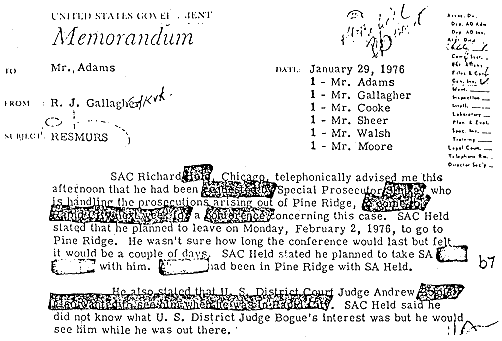
AIM's inclusion in the FBI's Domestic Terrorist Digest.
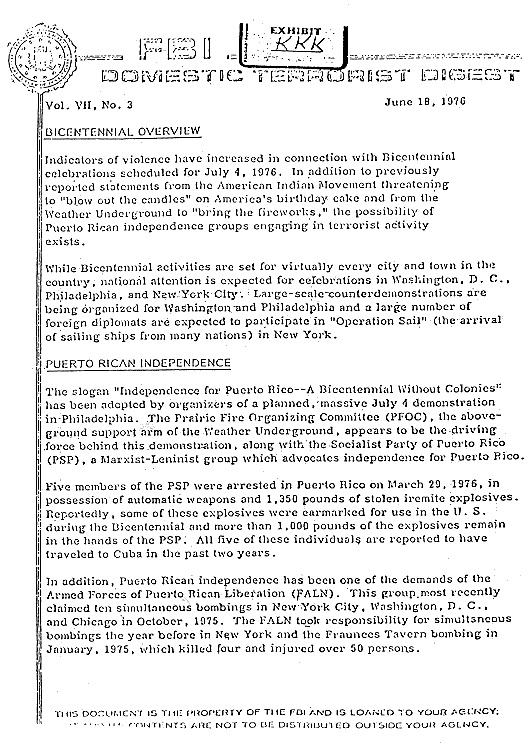
Application of such time-honored COINTELPRO expedients was hardly the only step undertaken by the FBI in seeking to undercut the judicial process at Cedar Rapids. The Bureau also managed to get trumped-up allegations of an attempted jail break by Butler and Robideau into the trial record 167 brought in a demonstrably bogus witness named James Harper to claim that both defendants had confessed to him in their cell 168 and - if their subsequent testimony during the trial of Leonard Peltier is any indication - allowed agents such as J. Gary Adams to perjure themselves. 169 It was also established in court that Adams, Olen Victor Harvey and other agents blatantly coerced false testimony from several key witnesses. 170 Still, presiding judge Edward McManus - "Speedie Eddie," certainly no friend of AIM allowed the defense to base its case in an argument for self-defense, contingent upon examination of the context of anti-AIM violence fostered on Pine Ridge by the FBI and its GOON cohorts from 1972 onwards. Butler and Robideau were thus able to call expert witnesses such as Idaho Senator Frank Church, who had headed up a major investigation of COINTELPRO and who testified that what the defendants were contending was quite in line with known FBI counterintelligence practices. 171 Similarly, U.S. Civil Rights Commission investigator William Muldrow went on the stand to testify that the Bureau had implemented a "reign of terror" at Pine Ridge. 172 Butler and Robideau never claimed not to have fired on Williams and Coler; they claimed instead that, under the circumstances the FBI itself had created on the reservation, they were justified in doing so. On July 16, 1976 the jury agreed, returning verdicts on "not guilty by reason of self-defense" upon both men. 173
Confronted by this unexpected defeat in court, the government was placed in something of a quandary as to what to do next. By July 20, 1976, as is shown in the accompanying teletype sent by ASAC Norman Zigrossi to Director Kelley and his associate, Richard G. Held, the Bureau had begun to analyze "what went wrong" during the Cedar Rapids prosecution. Zigrossi's conclusions - such as the defense being "allowed freedom of questioning of witnesses" and the allowing of testimony "concerning past activities of the FBI relating to COINTEL PRO [sic]" - had been accepted by the Bureau leadership. As is evidenced in the accompanying August 10 memo from B.H. Cooke to Richard J. Gallagher, a meeting was convened between Kelley and Held, along with FBI officials James B. Adams, Gallagher, John C. Gordon , and Herbert H. Hawkins, Sr., on the one hand and U.S. Attorney Evan Hultman, along with his director, William B. Gray, on the other. At the meeting, it was decided to pursue Held's strategy of prosecuting only non-Oglalas by dropping charges against Jimmy Eagle "so that the full prosecutive weight of the Federal Government could be directed against Leonard Peltier."The second of the so-called "Dog Soldier Teletypes".
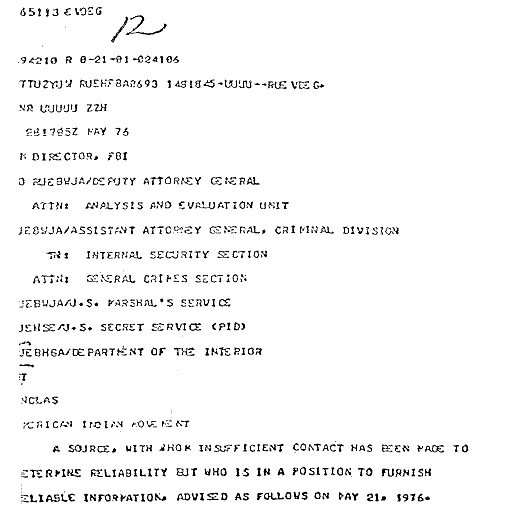

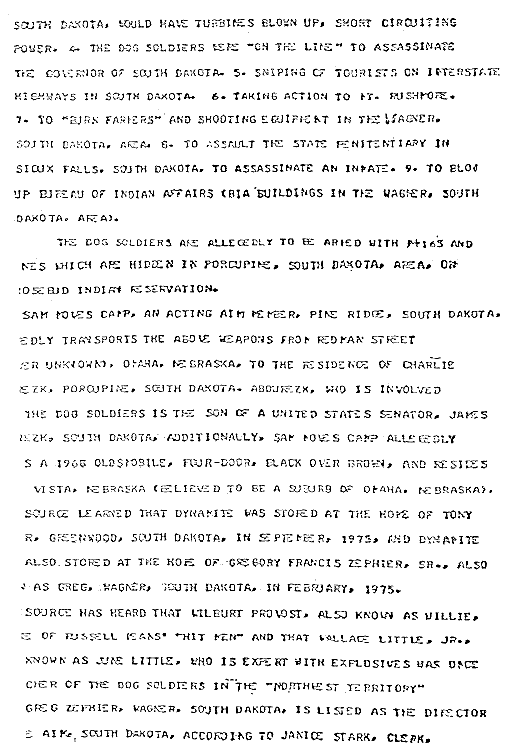
The next step was to do a bit of shopping for a judge. Just as McManus was used to replace Judge Fred Nichol after the latter reached conclusions unfavorable to the prosecution during the Banks-Means trial of 1974, so too was McManus arbitrarily replaced after allowing a semblance of due process during the first RESMUR trial. He was replaced by Judge Paul Benson, a former AUSA from North Dakota and Nixon appointee who had made considerable personal investment in Indian lands. After a series of meetings conducted in Rapid City with ASAC Zigrossi and his FBI colleagues, as well as prosecutor Hultman (defense attorneys were neither invited nor informed) - ostensibly held, in contradiction of every tangible shred of evidence concerning the organization's conduct during the many trials of its members, to develop security plans countering "expected AIM terrorism" - Benson staged a pretrial hearing on January 14, 1977. 174 During the proceeding, he announced the trial of Leonard Peltier would be moved from its scheduled location in Cedar Rapids, where AIM had developed strong support, to the far more conservative Fargo, North Dakota. He also began a sequence of evidentiary rulings which precluded Peltier's attorneys from developing the sort of self-defense case - centering on the FBI's COINTELPRO operations against AIM and other dissident groups - which had proven successful in the Butler-Robideau trial. 175Memo discussing sharing of RESMURS information with the CIA.
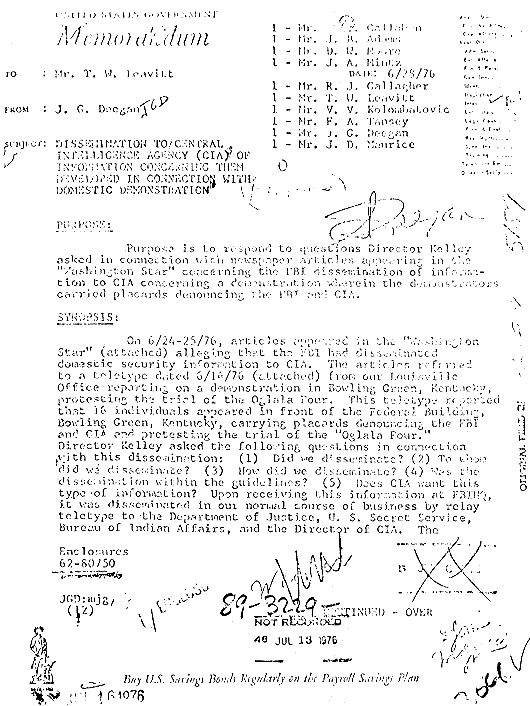
June 1976 teletype analyzing the recently concluded Cedar Rapids trial of Dino Butler and Bob Robideau. The purpose of the document is to determine "what went wrong" with the case against the first two RESMURS defendants, with an eye towards rigging the rules of the upcoming Peltier trial in order to obtain a conviction.
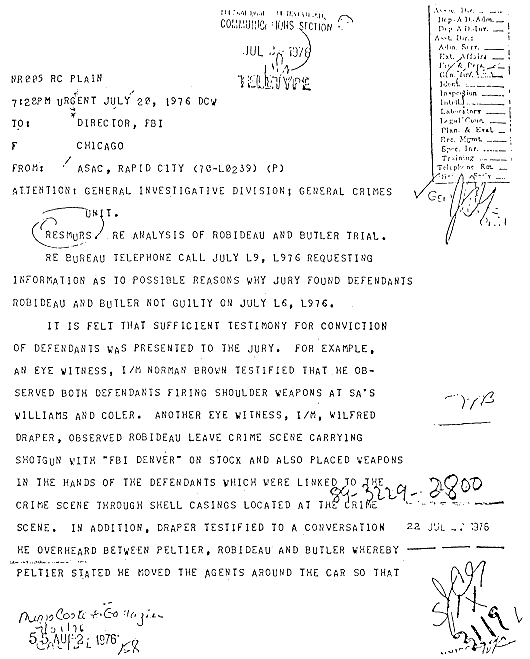


August 1976 memo capsulizing the decision to drop RESMURS charges against Jimmy Eagle in order to place "full prosecutive weight of the Federal Government" upon Leonard Peltier. It should be noted the FBI earlier alleged that Eagle had "confessed."

Meanwhile, the U.S. was engaged in fraudulently extraditing Peltier from Canada. This was done on the basis of a single piece of substantive evidence, an affidavit sworn to by an Oglala woman named Myrtle Poor Bear, who was supposedly an eyewitness to the deaths of Williams and Coler. As it turned out, Poor Bear had a history of deep psychological disorder, for which she had undergone extensive treatment. This seems to have been a matter well known to FBI agents David Price and William Wood when they essentially abducted her - she was charged with, and apparently suspected of, no particular crime - and held her incommunicado in motels in Gordon, Nebraska and Sturgis, South Dakota for approximately one month. 176 During this period, the agents prepared, and Poor Bear signed, not one but three mutually contradictory affidavits concerning Peltier's "guilt" in the RESMURS matter. 177 In the documents (which accompany this text), Poor Bear variously claimed to have witnessed and not to have witnessed the shootings, and to have been a "girl friend" of Peltier, to whom he "confessed" his deeds. At more or less the same time, Poor Bear was also signing affidavits prepared by Price and Wood to the effect that she was the girl friend of another AIM leader, Richard Marshall, to whom he had confessed the murder of an Oglala named Martin Montileaux. The Poor Bear "information" was the decisive factor in Marshall's first degree murder conviction and receipt of a life sentence on April 6, 1976. 178 It was also the key ingredient in Canadian justice W.A. Schultz's determination that Leonard Peltier should be extradited to the U.S., reached on June 18, 1976, and Minister of justice Ron Basford's order that the extradition be executed on December 16, 1976. 179
Affidavit 1, in which SAs David Price and William Wood have Myrtle Poor Bear recounting how it was she overheard the planning of the Northwest AIM group to lure SAs Coler and Williams to their deaths in an ambush. Note that there is no claim Poor Bear witnessed the firefight, but that she heard Leonard Peltier order the agents killed beforehand, and that he later "confessed to her."

Poor Bear later recanted all "evidence" she'd offered - both by affidavit and through direct testimony - against Peltier and Marshall, contending that she had been grossly coerced by the FBI into providing false information (e.g.: she'd witnessed nothing, and knew neither man in any way at all). 180 Among the methods used to achieve these results, aside from her virtual kidnapping by Price and Wood, appear to have been the use of morgue photos of the body of AIM member Anna Mae Aquash, who had earlier reported being threatened with death by Price unless she cooperated in the RESMURS investigation. 181Having been hustled back to South Dakota from Oregon by SA J. Gary Adams on February 10, after being arrested in the Brando motor home, Aquash had promptly disappeared. Her body - dead for several days -was discovered in a ravine near the village of Wanblee by Oglala rancher Roger Amiotte on February 24, 1976. Price was among a number of lawmen who atypically gathered to view the corpse in situ at this remote location, but claimed not to recognize the victim." 182 He and his partner, William Wood, then followed the ambulance carrying the body all the way to the Pine Ridge Hospital morgue (some 115 miles) where an autopsy was performed by the faithful coroner, W.O. Brown. Brown pronounced death to have been caused by "exposure," and ordered burial in a common grave at the nearby Red Cloud Cemetery. Prior to burial, Wood caused "Jane Doe's" hands to be severed and shipped - as is shown in the accompanying February 26, 1976 airtel from the Minneapolis SAC to Kelley - to the FBI crime lab in Washington, D.C., for "identification purposes." 183
[TIMELINE: Anna Mae Pictou Aquash]"Enclosed ... one pair of hands." Airtel sent as cover with the box containing Anna Mae Aquash's body parts to the FBI crime lab. It should be noted that had the Bureau followed usual procedures in attempting identification by dental x-ray, the bullet lodged in the victim's skull would have been revealed.
In any event, with Peltier illegally but securely in custody, and with the defense's hands tied by Judge Benson's odd assortment of evidentiary rulings, the FBI set about fabricating a "factual" basis upon which prosecutor Hultman could obtain a conviction. First, Bureau ballistics experts "established" - on the basis of no tangible evidence whatsoever - that Williams and Coler had been killed by shots fired from a .223 caliber AR-15 rifle. 188 A highly circumstantial case that an AR-15 had been fired into the agents at close range was made through introduction of a single shell casing allegedly found in the trunk of Coler's car (which had been open during the fighting), supposedly discovered, not during the FBI's initial examination of the car, but at some point well after the fact. 189Then, the head of the Bureau's Firearms and Tool Marks Unit, Evan Hodge, falsely cast the impression - the FBI already having (and hiding) conclusive evidence to the contrary - that only one AR15 was used by the Indians during the Oglala firefight. 190 From there, Hodge went on to testify that he had been able to link the cartridge casing purportedly recovered from Colers trunk to a weapon used by the Northwest AIM group and found in Bob Robideau's burned out car on the Kansas Turnpike. However, as is shown in the accompanying October 2, 1975 teletype from Hodge to Clarence Kelley, these ballistics tests had produced the exact opposite results. 191 But once the ballistics chief's assertions on the stand were accepted by the jury, it followed that whoever among the Northwest AIM group could be shown to have carried an AR-15 during the firefight would be viewed, ipso facto, as the "murderer."Then came the piece de resistance. SA Fred Coward was put on the stand to testify - as he had not been at Cedar Rapids - that in the midst of the firefight he had been peering through a meager 2x7 rifle scope. At a distance of "approximately 800 meters" (about one-half mile), through severe atmospheric heat shimmers, he claimed to have recognized Leonard Peltier, whom he admitted he had never seen before that moment. Peltier, Coward claimed, was running away from the location of the dead agents' cars - at an oblique angle to Coward's position, so that the identification had necessarily to be made in profile - carrying an AR-15 rifle. 192 With that, AUSA Lynn Crooks, who at Cedar Rapids had vociferously contended that Coler and Williams had died at the hands of a "gang of ruthless ambushers," reversed himself before the Fargo jury arguing that Peltier had been a 'lone gunman":Apparently Special Agent Williams was killed first. He was shot in the face and hand by a bullet ... probably begging for his life, and he was shot. The back of his head was blown off by a high powered rifle Leonard Peltier then turned, as the evidence indicates, to Jack Coler lying on the ground helpless. He shoots him in the top of the head. Apparently feeling he hadn't done a good enough job, he shoots him again through the jaw, and his face explodes. No shell even comes out, just explodes. The whole bottom of his chin is blown out by the force of the concussion. Blood splattered against the side of the car." 193Under the weight of such cynical and deliberately sensational dosing argumentation, unhampered by a number of exculpatory documents the FBI had secretly withheld despite defense discovery motions, the jury found Peltier guilty on two counts of first degree murder on April 18, 1977. Judge Benson then again did his part, passing life sentences on each count, to run consecutively. Contrary to stated U.S. Bureau of Prisons (BoP) policy - which held at the time that the facility was reserved for "incorrigible" repeat offenders (Peltier had no prior convictions) and those who have created major problems within other facilities of the federal prison system - the defendant was taken directly to the super maximum security federal prison at Marion, Illinois.An appeal of Peltier's conviction was immediately filed with the U.S. Eighth Circuit Court of Appeals, based more-or-less equally on Judge Benson's evidentiary rulings and documented FBI misconduct both in and out of court. The appeals case was compelling, as is reflected in the observation of one of the judges on the three member panel, Donald Ross, in connection with the Poor Bear affidavits:But can't you see ... that what happened, happened in such a way that it gives some credence to the claim of the ... Indian people that the United States is willing to resort to any tactic in order to bring somebody back to the United States from Canada. And if they are willing to do that, they must be willing to fabricate other evidence as well [emphasis added]." 194This teletype, among the exculpatory documents withheld by the FBI during the trial of Leonard Peltier, shows that Bureau ballistics tests conclusively determined that the rifle attributed to the defendant had not fired the cartridge casing allegedly recovered from the trunk of SA Coler's car. FBI firearms expert Evan Hodge testified to the opposite at trial.
FBI lab notes detailing filing pin test performed with the "Wichita AR-15," showing that it did not match the crucial casing recovered at RESMURS scene. At trial, Evan Hodge testified that the test was "inconclusive."
In the end, however, while noting serious problems with the FBI's handling of "certain matters," and consequently expressing considerable "discomfort" with their decision, the judges opted to allow the judgment against Peltier to stand on February 14, 1978. 195 An explanation of this strange performance may perhaps be found in the fact that shortly thereafter, William Webster - Chief Judge of the Eighth Circuit Court, and initial chair of the panel which considered Peltier's appeal - left the court for a new job: he had been named Director of the FBI, a matter of which he was aware well before the Peltier decision was tendered. 196 On February 11, 1979, the U.S. Supreme Court refused, without explanation, to review the lower court's decision. 197In 1981, as a result of an FOIA suit filed by Peltier's attorneys, some 12,000 pages of previously classified FBI documents relating to the Peltier case were released (another 6,000-odd pages were withheld under the aegis of "national security" in this purely domestic matter). 198 Based upon precedents that the withholding of exculpatory evidence - such as the accompanying October 2, 1975 ballistics teletype - by the prosecution was grounds for retrial, an appeals team filed a motion in this regard with Judge Paul Benson in April of 1982. Since certain documents obtained through the FOIA also revealed what appear to have been improper pretrial meetings between the prosecution, the FBI and Benson, the judge was simultaneously asked to remove himself from further involvement in the proceedings. 199 This was essentially pro forma; given his previous record in the Peltier case, few were surprised when Benson rejected both of these motions on December 30, 1982.A new appeal was then filed with the Eighth Circuit Court and, on April 4, 1984, the appeals court reversed Benson's decision. Citing the apparent contradiction implied by the October 2, 1975 teletype, and the critical nature of the .223 casing to the government's case, the court ordered an evidentiary hearing on the ballistics evidence. 200 The hearing was held in Paul Bensons regular courtroom in Bismarck, North Dakota at the end of October 1984. There, a very nervous Evan Hodge explained that the obvious conflict between his trial testimony and the documentary record arose from a "misinterpretation." 201 Although Hodge steadily dug the hole deeper and was eventually caught by William Kunstler committing what would for "civilians" be described as outright perjury, Benson still allowed the distraught agent to resume the stand and retract his testimony. 202 The judge then ruled that Peltier's conviction would stand.This decision was anticipated, and the appeals team went straight back to the Eighth Circuit Court. In oral arguments heard before the court on October 15,1985, prosecutor Lynn Crooks was forced to abandon his flamboyant assertions - made at trial - that Peltier was a "cold blooded murderer." Instead, as Crooks now admitted the government "[didn't] really know who shot those agents." 203 Thus, he was willing to concede that the murder case conjured up against the defendant by the FBI no longer really existed. Peltier, the prosecutor now lamely contended again in stark contrast to his trial presentations - wasn't even in prison for murder, but rather for aiding and abetting in two murders. 204 Faced with official contradictions of this magnitude, the appeals court deliberated for nearly a year, finally handing down a decision on September 11, 1986. Although they rejected Crooks' argument concerning aiding and abetting - noting that Peltier had plainly been convicted of performing the murders himself - while detailing how the evidentiary basis for such a conviction had been eroded, probably beyond hope of repair, they still allowed the conviction to stand. Their collective motivation in reaching this untenable conclusion was put straightforwardly in one brief passage of their opinion:There are only two alternatives ... to the government's contention that the .223 casing was ejected into the trunk of Coler's car when the Wichita AR-15 was fired at the agents. One alternative is that the .223 casing was planted in the trunk of Coler's car either before its discovery by the investigating agents or by the agents who reported its discovery. The other alternative is that a non-matching casing was originally found in the trunk and sent to the FBI laboratory, only to be replaced by a matching casing when the importance of a match to the Wichita AR-15 became evident ... We recognize that there is evidence in this record of improper conduct on the part of some FBI agents, but we are reluctant to impute even further improprieties to them [emphasis added]. 205Thus, the appellate court left Peltier in the midst of a double-life sentence for "crimes" both it and the trial prosecutor acknowledged had never been proven rather than delve more deeply into the illegal FBI activities attending his case. The defense immediately petitioned for reconsideration by the full Eighth Circuit Court rather than the three member panel - composed of judges Gerald Heaney, Donald Ross and John Gibson - which had rendered the decision. 206 The en banc hearing was denied several months later, a development which left the appeals team with no alternative but to once again petition the Supreme Court. 207 On October 5, 1987, the high court refused, for the second time and again without explanation, to review the case of Leonard Peltier. 208 Judge Heaney later described the decision as the most difficult of his legal career because, in his view, "the FBI was at least as responsible for what happened as Leonard Peltier. " 209 The judge failed to explain why, if this is the case, only Peltier is sitting in prison - without legal recourse - while the FBI agents involved have been allowed to simply go on about their business.Implications of COINTELPRO-AIMIn many ways, the stark unwillingness of the federal government to accord Leonard Peltier even a modicum of elementary justice is symbolic of the entire AIM experience during the 1970s and, more broadly posed, of the U.S. relationship to American Indians since the first moment of the republic. The message embedded, not only in Peltier's imprisonment, but in the scores of murders, hundreds of shootings and beatings, endless show trials and all the rest of the systematic terrorization marking the FBI's anti-AIM campaign on Pine Ridge, was that the Bureau could and would make it cost-prohibitive for Indians to seriously challenge the lot assigned them by policy-makers and economic planners in Washington, D.C. The internal colonization of Native America is intended to be absolute and unequivocal.Thus it was that AIM, arguably the most hopeful vehicle for some meaningful degree of indigenous pride and self determination in the U.S. during the late 20th century was destroyed as a viable national political organization. In the end, as Dennis Banks has observed:
The FBI's tactics eventually proved successful in a peculiar sort of way. It's remarkable under the circumstances - and a real testament to the inner strength of the traditional Oglalas - that the feds were never really able to divide them from us, to have the traditionals denouncing us and working against us. But, in the end, the sort of pressure the FBI put on people on the reservation, particularly the old people, it just wore 'em down. A kind of fatigue set in. With the firefight at Oglala, and all the things that happened after that, it was easy to see we weren't going to win by direct confrontation. So the traditionals asked us to disengage, to try and take some of the heaviest pressure off. And, out of respect, we had no choice but to honor those wishes. And that was the end of AIM, at least in the way it had been known up till then. The resistance is still there, of course, and the struggle goes on, but the movement itself kind of disappeared. 210The logic of COINTELPRO, as evidenced in this excerpt from a 1976 document concerning the basis for an "investigation" of AIM and its supporters. Note the mention of the deliberate fostering of "paranoia" among AIM leaders through the use of informers, and insistence that the right of government to suppress dissent outweighs the rights of citizens to "privacy and free expression."
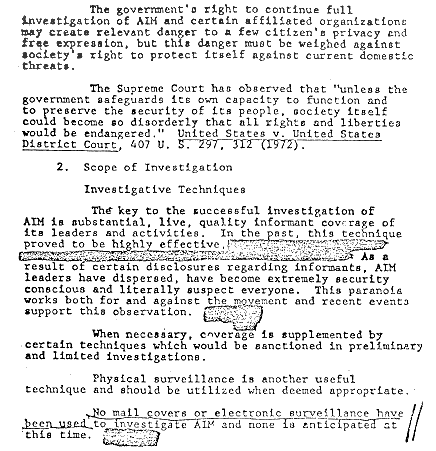
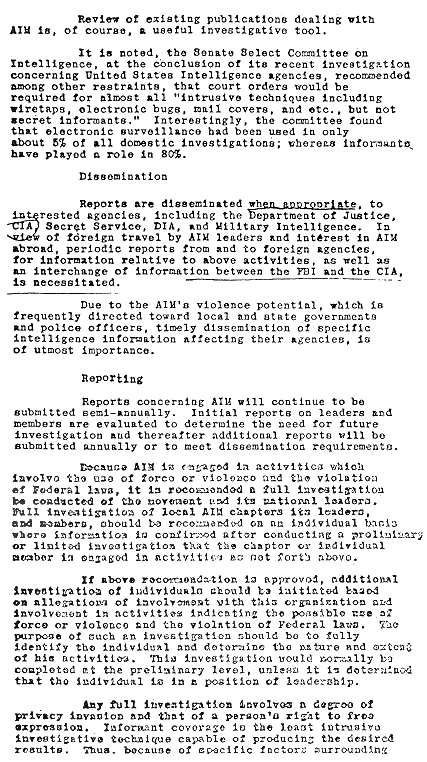
At another level, the nature of the FBI's assault against AIM during the mid-1970s demonstrated the willingness and ability of the Bureau to continue COINTELPRO-style operations even at the moment such methods were being roundly condemned by the Senate Select Committee on Intelligence Activities, and FBI officials at the highest levels were solemnly swearing before congress that all such "techniques" had been abandoned, long since. Indeed, as has been shown in this chapter, there is ample evidence that - at least in terms of sheer intensity and lethal results - the counterintelligence program directed at AIM represented a marked escalation over what had been done when such things had been designated by the formal COINTELPRO acronym. As Russell Means has put it, "COINTELPRO is COINTELPRO, no matter what they choose to call it." 211Further, getting away with COINTELPRO-AIM at the precise instant it was supposedly being chastised and "reformed" due to earlier COINTELPRO "excesses" appears to have inculcated within the Bureau hierarchy a truly overweening sense of arrogance. 212 They were quite prepared to openly defend the rationale of COINTELPRO, even while pretending to disavow it, a matter readily evidenced in the accompanying excerpt from the FBI's June 1976 "Predication for Investigation of Members and Supporters of AIM," a position paper drafted by Richard G. Held and delineating the thinking underlying what was being done to the organization. The right of the government to "defend itself" from dissent, in this official Bureau view, clearly outweighs the rights of citizens to "privacy and free expression."In 1953, just prior to the passage of PL-280, Felix Cohen, one of the foremost scholars of Indian law compared the role of the Indians in America to that of the Jews in modem Germany. He noted that, "Like the miner's canary, the Indian marks the shift from fresh air to poison air in our political atmosphere ... our treatment of Indians, even more than our treatment of other minorities, reflects the rise and fall of our democratic faith." 213 Given that all that happened on and around Pine Ridge occurred long after COINTELPRO allegedly became no more than a "regrettable historical anomaly," 214 Cohen's insight holds particular significance for all Americans. In essence, if we may ascertain that COINTELPRO remained alive and well years after it was supposed to have died, we may assume it lives on today. And that, to be sure, is a danger to the lives and liberties of everyone.End of Chapter 7
